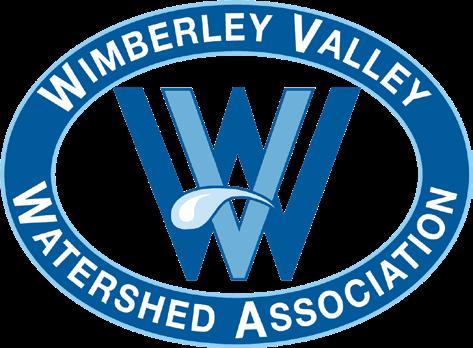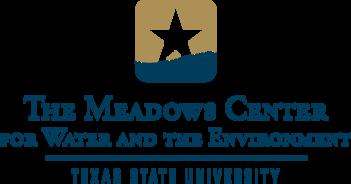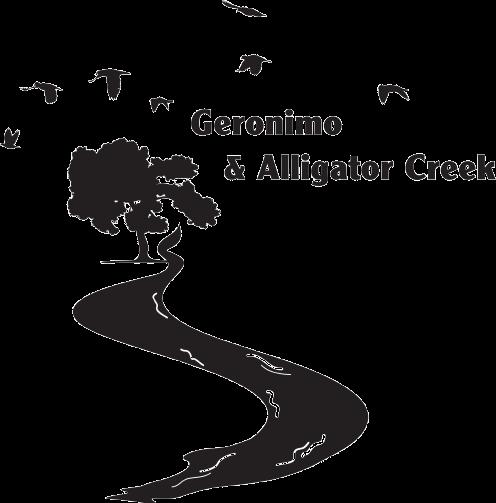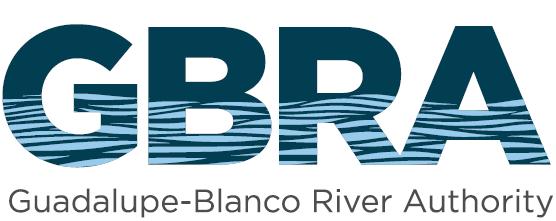2023 BASIN SUMMARY REPORT
Clean Rivers Program
Guadalupe River and Lavaca-Guadalupe
Coastal Basins

Guadalupe River Watershed
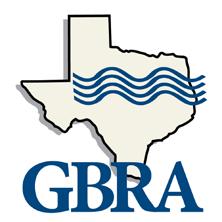








Peach C r e e k PlumCreek San diesCreek SanMarcosRiver Blanco River Guadalupe River Guadalupe R vi e r 15 1 2 3 7 8 13 14 12 11 4 5 9 10 6 Boerne Lockhart New Braunfels Bandera Karnes City Austin Kerrville La Grange Seguin Hallettsville Johnson City Fredericksburg Gonzales Floresville Cuero San Antonio Bastrop San Marcos Victoria Refugio Port Lavaca Goliad
¯ 0 25 50 12.5 Miles 1 Guadalupe River Above Flat Rock Dam 2 Guadalupe River Below Flat Rock Dam 3 Blanco River 4 Canyon Lake 5 Comal River 6 Guadalupe River Below Canyon Dam 7 San Marcos River 8 Plum Creek 9 Geronimo Creek 10 Guadalupe River Below Comal River 11 Peach Creek 12 Sandies Creek 13 Lower Guadalupe River 14 Coleto Creek 15 Lavaca-Guadalupe Coastal LAB LABEL_NAME BASIN MAP 2023 BASIN SUMMARY REPORT 2
The Guadalupe River Basin covers portions of seventeen counties and has 15 distinct sub-watersheds. This unique and diverse river basin flows through several ecoregions as it makes its way to San Antonio Bay and finally, the Gulf of Mexico. Many endemic and endangered species call the Guadalupe River Basin home, including the whooping crane, Guadalupe orb, and Texas wild rice.
Bacteria is the most common impairment in the basin, followed by dissolved oxygen. The most common statistically significant trends that were identified throughout the basin were changes in chloride and sulfate levels, which could be a result of changing rainfall patterns leading to changes in runoff.
Population growth, land use changes, and aging infrastructure are some of the biggest challenges in the basin. To maintain and improve water quality, focus should be placed on managing stormwater runoff, educating stakeholders in the basin on water quality best management practices, and proactively planning for the increasing population.
Stakeholders in the Guadalupe River and Lavaca-Guadalupe Coastal basins have greatly benefitted from the monitoring provided by the Clean Rivers Program. An incredible amount of data has been collected over the past three decades by the Clean Rivers Program partners in this basin. Data collected under this program has been utilized by stakholders to develop watershed protection plans in five watersheds in the basin, including Plum Creek watershed, Geronimo & Alligator Creek watershed, Cypress Creek watershed, the Dry Comal Creek & Comal River watershed, and the Upper San Marcos River watershed. The public outreach opportunities provided by the Clean Rivers Program have increased public knowledge and involvement with the waters of the river basin through public outreach, volunteer monitoring training, and school programs.
3
Segments in the Basin
impaired for Bacteria
27 37% 56.4%
impaired for depressed DO
11% have a concern for nitrates
15% have no impairments
22% Newly Proposed ESA Candidates
All freshwater mussles
Some of the Fastest-Growing Cities in Texas in the last 10 years
New Braunfels Kyle 63% San Marcos
increases in population
6,417
30% miles of rivers, creeks, and streams
6,061
square-mile basin
EXECUTIVE SUMMARY
3 EXECUTIVE SUMMARY
TABLE OF CONTENTS Front Cover: Honey Creek at Guadalupe River State Park Back Cover: GBRA Water Quality Tech Collecting Data at Guadalupe River near Sisterdale 2023 BASIN SUMMARY REPORT 4 Executive Summary Executive Summary ............................................................................................. 3 Introduction Objectives and Goals of the Clean Rivers Program ................................. 5 Coordination and Cooperation with Other Entities ................................ 6 Overview of the Guadalupe River Basin ....................................................... 7 Summary of Water Quality Characteristics ................................................. 8 Public Involvement The Guadalupe River Basin Steering Committee ..................................... 9 Education and Outreach at GBRA................................................................... 9 Education and Outreach at UGRA ............................................................... 10 Water Quality Review Water Quality Terminology ............................................................................. 13 Data Review Methodology ............................................................................. 16 Watershed Summaries Guadalupe River above Flat Rock Dam ...................................................... 23 Guadalupe River below Flat Rock Dam ...................................................... 29 Canyon Lake ........................................................................................................ 33 Guadalupe River below Canyon Dam ......................................................... 37 Comal River .......................................................................................................... 40 Guadalupe River below Comal River........................................................... 44 Geronimo Creek ................................................................................................. 49 Blanco River .......................................................................................................... 52 San Marcos River ................................................................................................ 59 Plum Creek ........................................................................................................... 64 Lower Guadalupe River .................................................................................... 68 Sandies Creek ...................................................................................................... 73 Peach Creek ......................................................................................................... 77 Coleto Creek ........................................................................................................ 80 Lavaca-Guadalupe Coastal Basin ................................................................. 83 Conclusion and Recommendations Conclusion ............................................................................................................ 86 Recommendations ............................................................................................ 86
as well as changes and trends in the river basin. It also serves to enhance the ability to make decisions regarding water quality issues. The report is completed every five years, but the period of record for analysis includes at least ten years so long-term trends are discernible. In addition to the water quality data review, the report contains highlights of events, monitoring activities, and identifies issues and concerns in the Guadalupe River and Lavaca-Guadalupe Coastal basins under the Clean Rivers Program (CRP) as well as opportunities for the public to have input into the program. The CRP is managed by the Texas Commission on Environmental Quality (TCEQ) and funded entirely by fees assessed to wastewater and water rights permit holders. The Guadalupe-Blanco River Authority (GBRA), together with the Upper Guadalupe River Authority (UGRA), carry out the water quality management efforts in these basins under contract with the TCEQ.
Objectives and Goals of the Clean Rivers Program
The Texas Legislature passed the Clean Rivers Act in 1991, which requires water quality assessments for each river basin in Texas. In accordance with the Act, the TCEQ administers the Clean Rivers Program in partnership with river authorities, municipal water authorities, councils of governments, and other regional entities. The goal of the program is to maintain and improve water quality within each river basin through these partnerships. The TCEQ, GBRA, UGRA, Meadows Center for Water and the Environment (MCWE), and Wimberley Valley Watershed Association (WVWA) gather data from the Guadalupe River, its sub-watersheds, and coastal basins in a watershed management approach in order to identify and evaluate water quality issues, establish priorities for corrective action, work to implement those actions, and adapt to changing priorities. Examination of long-term data allows comparison between current and historical water quality data, and statistical analysis can indicate any trends in improvement or deterioration of water quality parameters.

INTRODUCTION
5 INTRODUCTION
Upper Blanco River
GBRA, UGRA, MCWE, and WVWA coordinate with other entities interested in water quality monitoring in the Guadalupe River Basin. Those entities include the TCEQ, United States Geologic Survey (USGS), Texas Parks and Wildlife Department (TPWD), Texas State Soil and Water Conservation Board (TSSWCB), and Texas Stream Team. Annually, all cooperators monitoring in the basin meet to coordinate their activities. This coordination minimizes duplication, focuses monitoring and resources where needed, and helps prevent voids in coverage across the basin.

The Guadalupe River Basin Clean Rivers Program supports Texas Stream Team monitoring groups in the basin. GBRA supplies replacement chemicals and provides training for monitoring and quality assurance to the volunteer monitors in the basin. Currently there are groups monitoring the Guadalupe River near Seguin, Cypress Creek in Wimberley, the San Marcos River, the Blanco River and tributaries, the Comal River and Canyon Reservoir, and Plum Creek and its tributaries.
Another example of the role that CRP plays in the basin is the contribution of quality-assured data used in the watershed planning efforts going on in the river basin. The water quality data collected by the Clean Rivers Program is used by TCEQ to assess streams to determine if they are meeting the stream standards for their designated uses. Secondly, the data is used to determine the need and extent that watersheds could benefit from watershed protection plans (WPP). There are five watershed protection plans currently implemented in the Guadalupe River Basin, including Plum Creek, Geronimo and Alligator Creeks, Cypress Creek, Upper San Marcos River, and Dry Comal Creek and Comal River. With the exception of the Upper San Marcos River WPP, the goals of these plans are to address water quality concerns and impairments through stakeholder education and outreach, best management practice (BMP) implementation, and water quality monitoring to assess the efficacy of the implementation measures. The Upper San Marcos River does not currently have any water quality concerns or impairments; the goal of their plan is to proactively manage water quality through education and BMPs. GBRA assists several of the WPPs in the basin through technical assistance and water quality monitoring.
2023 BASIN SUMMARY REPORT 6
Guadalupe River at G Street in Kerrville
Overview of the Guadalupe River Basin
The Guadalupe River Basin is located in south central Texas, with the headwaters in the Hill Country region. The main stem of the river is 432-miles-long and flows southeastward through a drainage area of 6,061-square-miles. The land mass that makes up the basin is divided into two distinct regions by the Balcones Escarpment. The northern region consists of the Edwards Plateau of the Great Plains Province. The area has variable topography, with rolling hills divided by limestone-walled valleys. The southern region consists of gently sloping prairie and is referred to as the Gulf Coastal Plains area. The basin’s principle tributaries are the North and South Fork of the Guadalupe River, Johnson Creek, the Comal River, the Blanco River, the San Marcos River, Geronimo Creek, Plum Creek, Peach Creek, Sandies Creek, and Coleto Creek.
The key factors influencing water quality in the basin are geology, ground water, soils, climate, vegetation, and land uses. Weather over the ten-year period of this report has been more extreme and less predictable than in previous decades. According to the National Oceanic and Atmospheric Administration (NOAA), 2015 was the wettest year on record in New Braunfels; the area received 43.45 inches of rain while the annual average is 34.95 inches. 2022 was the driest year on record for the same area; only 14.26 inches of rain fell. Though rainfall has increased in recent months, as of the time of this report most of the Guadalupe River Basin is still under drought conditions (Figure 1). The headwaters and upper portion of the basin are currently under extreme to exceptional drought; the Guadalupe River directly above Canyon Lake went dry for several months during 2022 (Photo 1).

February 7, 2023 Valid 7 a m EST (Released Thursday, Feb. 9, 2023) Author: Brian Fuchs Nationa Drought M tigat on Center U.S.
Texas droughtmonitor.unl.edu The Drou ght Monitor ocuses o n b ro ad-scale co nd tion s Local cond t ons ma y vary For more nforma ion on the Drou ght Mon ito r, g o o h tps /droug htmon to r un edu /Abou aspx Intensity: D0 Abnorma ly Dry D1 Moderate Drought D2 Severe Drought D3 Extreme Drought D4 Except ona Drought None
Drought Mo nitor
Photo 1: Dry Guadalupe River Bed at RR 311 Near Spring Branch
7 INTRODUCTION
Figure 1: Texas Drought Monitor Map
Summary of Water Quality Characteristics
The water quality of the Guadalupe River is highly influenced by the groundwater that makes up its baseflow. The largest groundwater contribution to the baseflow is the Edwards Aquifer, with additional volume from the Cow Creek, Trinity, Leona, Carrizo, and Gulf Coast aquifers. The headwaters of the Guadalupe are located in Kerr County, and originate from springs in the North and South Forks. The discharge of the Edwards Aquifer from Comal and San Marcos springs form two small, crystal clear lakes, which support aquatic vegetation and wildlife, including the fountain darter and Texas wild rice, two federally endangered species. Springs that come from the Leona Formation, which is high in nitrate-nitrogen, are suspected to be a partial source of the nutrient concern and dissolved solids in Plum and Geronimo creeks.
The Guadalupe River flows through Kerr and Kendall counties and into Canyon Reservoir, the largest reservoir in the basin, located in Comal County. Canyon Lake impounds water for water supply, flood control, and recreation. Downstream of Canyon Reservoir, the Guadalupe River flows over bedrock substrate and through swift water runs. The river is shallow, with few pools until it nears the city of New Braunfels, where it meets with the Comal River and enters the first of six hydroelectric impoundments. From Kerr County to Refugio County, the Guadalupe River receives treated wastewater discharges. The cities of Kerrville, Boerne, Buda, New Braunfels, Kyle, San Marcos, Lockhart, Luling, Seguin, Gonzales, Cuero, and Victoria, along with other small wastewater treatment plants, discharge treated wastewater. Most of these plants provide at least secondary treatment of the wastewater to reduce total suspended solids (TSS) and dissolved organic material.
At the lower end of the basin, the San Antonio River joins the Guadalupe River. The Guadalupe River Diversion Canal and Salt Water Barrier are located below the confluence with the San Antonio River. The Salt Water Barrier is made up of steel gates that are used to prevent salt water intrusion from the bay during times of low river flows. The Guadalupe River Diversion Canal and associated canal system diverts fresh water for irrigation and municipal water supply.
2023 BASIN SUMMARY REPORT 8
The Guadalupe River Basin Steering Committee
A major communication vehicle for the CRP is the Basin Steering Committee. Composed of community leaders and interested citizens from throughout the basin, this group meets annually to review activities and advise the program on priorities for monitoring and special studies. The Steering Committee membership includes: representation from municipalities, counties, industries, homeowner organizations, TSSWCB, TPWD, chambers of commerce, and local regional environmental organizations. Steering Committee meetings are open to the public with the primary purpose of reviewing and approving achievable basin water quality objectives and priorities, considering available technology and economic impacts, and guiding work plans and the allocation of available resources. Notice of the Steering Committee meetings is made available by emailed notices, social media, and on the meeting page of the GBRA website (www.gbra.org).
Additionally, all water quality data collected by GBRA is available to the public. It can be found on the GBRA website (https://www.gbra.org/ environmental/water-quality/) or on TCEQ’s website (https://www.tceq.texas.gov/waterquality/clean-rivers/data/crp-resources.html).
Education and Outreach at GBRA
The GBRA Education program has been in existence since 1985, and has grown to be one of the most respected in the state. Over 13,000 students were reached in school year 2021-22 through a variety of in-school curriculum supplements, loaner trunks, and online and outdoor efforts. Approximately 7,400 of those were direct face-to-face instruction. The decades old award-winning Journey Through the Guadalupe River Basin program reached 4,000 students, and trunk loaner programs reached 5,400 students. In addition, monthly website analogs track thousands of people using GBRA online resources.
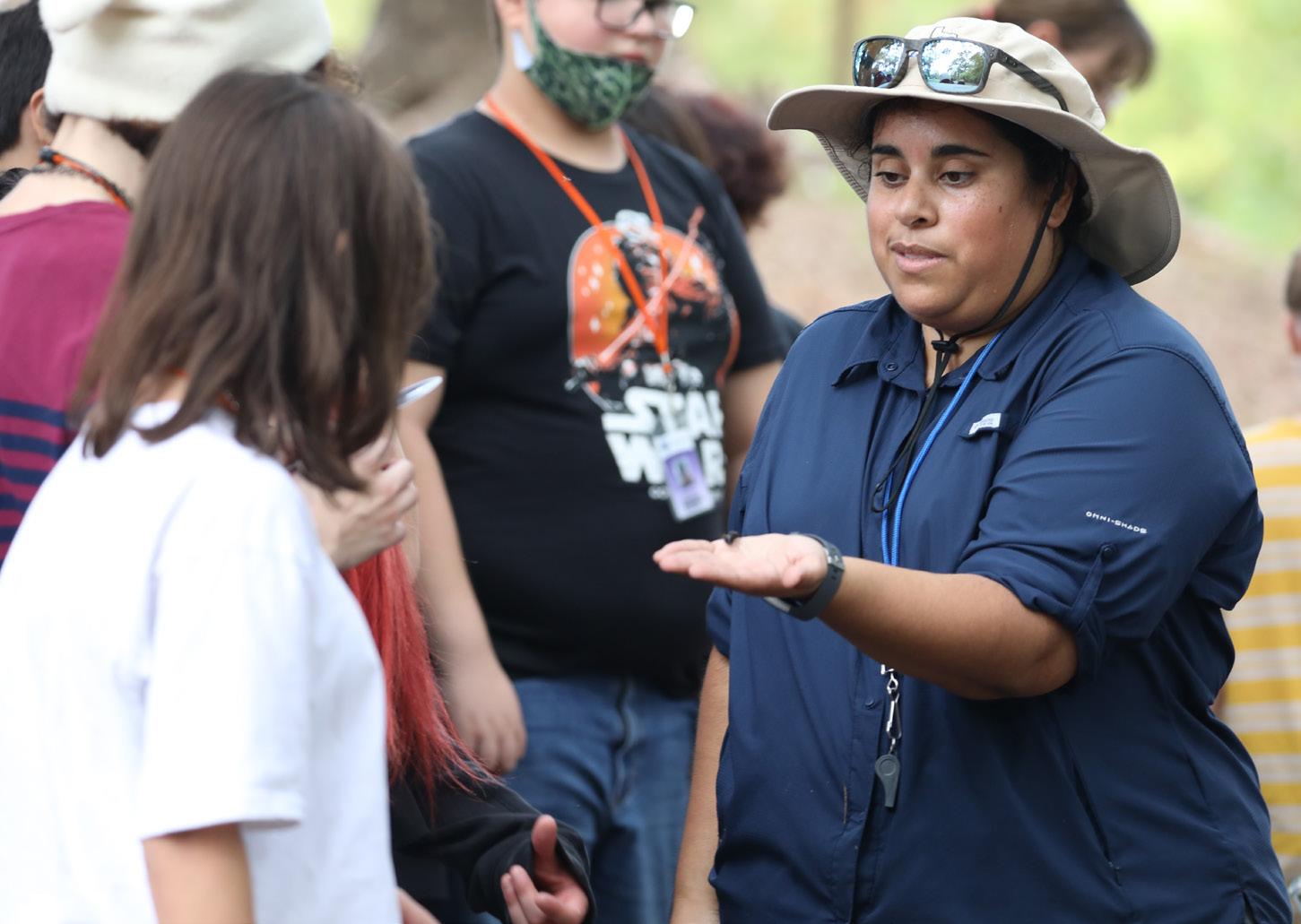
Use of in-school curricula supplements indicate the value of GBRA Education programming. Water Makes the World Go Round, a third grade supplement, introduces students to the world of water, focusing on properties, the water cycle, uses, and conservation. The fourth grade Journey program, correlated to state education standards, focuses on watersheds and water quality specific to the Guadalupe River Basin. The program also covers the water cycle, population growth, water uses in the basin, and water conservation.
The GBRA trunk program, initiated during the height of the COVID-19 pandemic, was an attempt to keep educators and students engaged during those trying times. Thousands of students have benefitted from use of these hands-on lessons. Trunk topics include weathering and erosion, the water cycle, water properties, watersheds, and
PUBLIC INVOLVEMENT
9 PUBLIC INVOLVEMENT
Middle School Students Explore River Ecology
groundwater-surface water interactions. Requests for the trunks remain strong.
Secondary efforts include the unique online program, "Waters to the Sea, Guadalupe River." This is a multi-media program used primarily at the middle school level throughout the river basin. This interactive learning program emphasizes relationships between human activities and water resources within the Guadalupe watershed from the river’s headwaters to San Antonio Bay. Target engagement for high school students is through Aquatic Science and Environmental Science programs. GBRA’s Interactive Learning section of the website provides opportunities to explore topics such as non-point source pollution, riparian systems, wastewater treatment, septic systems, etc.
Working outdoors with students is extremely impactful, so Education staff makes a concerted effort towards this in both the Plum and Geronimo Creek watersheds. Plum Creek watershed presentations and water quality testing (using Texas Stream Team methods) has taken place since 2007. In addition, GBRA presents lessons during Lockhart State Park school events. Those outdoor water quality lessons focus on issues in Plum Creek, including bacterial pollution, erosion and non-point source pollution. Impact at Plum Creek area schools during 2022 was just under 700 students.
Similar efforts are taking place in the Geronimo Creek watershed. GBRA Education has worked extensively with students and the public at the Irma Lewis Seguin Outdoor Learning Center since 2004. Most recently, extensive programming was possible through a 2018 non-point source grant from TCEQ. Extended through 2023, the grant provides opportunities for students from local school districts to learn about the Geronimo Creek watershed. Outdoor water quality lessons focus on issues in the creek, including non-point source pollution, bacterial pollution, riparian systems, and erosion.
Student events include the use of various tools, including a stream trailer model and erosion kits. Impact during 2021-22 was over 2,600 students.
Education and Outreach at UGRA Water Quality Monitoring
UGRA is an active Texas Clean Rivers Program partner and performs routine sampling at twelve sites quarterly and seven sites monthly. In addition, UGRA conducts multiple in-house sampling programs that focus on tributaries of the Guadalupe River, bacteria levels at popular recreation sites, and engage the community in water quality monitoring through a citizen science sampling effort.
Central to these diverse water monitoring programs is the nationally accredited UGRA Environmental Laboratory, a full-service laboratory serving the entire Hill Country. The laboratory is accredited according to the National Environmental Laboratory Accreditation Program and is one of the largest microbiological laboratories in the region.
In addition to evaluating routine water quality parameters, UGRA staff also contribute to monitoring of streamflow and the presence of invasive plants and animals.
2023 BASIN SUMMARY REPORT 10
Watershed Stewardship
As a steward of the upper Guadalupe River in Kerr County, UGRA programs and activities focus on preserving the health of our watershed. Some programs focus on reducing the impact of a specific threat to water quality like litter, pet waste, or feral hogs. While others demonstrate beneficial practices like preventing erosion on hillsides, preserving riparian area function, and reducing stormwater runoff. UGRA also provides incentives for both urban and rural landowners to contribute to the health of the upper Guadalupe River watershed. UGRA provides financial assistance to aid in brush management efforts and coordinates free treatment by TPWD to assist landowners with managing invasive giant cane (Arundo donax) on their properties.
To promote water conservation and reduce stormwater runoff, UGRA encourages the practice of rainwater harvesting by offering a rebate up to $500 on the purchase of rainwater harvesting equipment. In 2022, UGRA launched the Rainwater System Grant Program to promote the construction of higher capacity rainwater catchment systems by nonprofit organizations, schools, and public entities (Photo 2). UGRA is also preparing to introduce a rebate program to incentivize local use of low impact development strategies to manage stormwater runoff.
UGRA is privileged to support landowner activities that conserve water, prevent pollution, conserve soil, support native flora and fauna, and provide clean water for all. Learn more at www.ugra.org.
Public Education
Part of UGRA’s mission is to facilitate the understanding of water issues and engage the community in maintaining and promoting the health and enjoyment of the Upper Guadalupe River Basin. UGRA staff prepares presentations for schools, clubs, organizations, and summer camps to teach about water quality, pollution threats, conservation, the water cycle, and the importance of the Guadalupe River to the community. UGRA’s public awareness campaign keeps the community informed of water issues through newspaper features and radio announcements.

11 PUBLIC INVOLVEMENT
Photo 2: Hunt School Receiving Funds for Rainwater Catchment System
The UGRA EduScape (Photo 3) continues to be an educational asset as a demonstration landscape. Through partnership with Riverside Nature Center, virtual and in person tours of the EduScape are conducted and many visitors also stop by for a self-guided tour. In 2022, UGRA was awarded funding through the Native Plant Society of Texas Monarch Garden Grant to install more native plants in the EduScape to promote monarch butterfly conservation.

2023 BASIN SUMMARY REPORT 12
Photo 3: The UGRA EDUscape
FIELD PARAMETERS are water quality constituents that can be collected on-site and generally include: temperature, pH, conductivity, dissolved oxygen, stream flow, and secchi disc.
Temperature of the water affects its ability to hold dissolved oxygen. It can also impact the biological functions of aquatic organisms.
Conductivity is the measurement of dissolved salts such as chloride, sulfate, and sodium in the stream as well as the streams capacity to conduct electricity. Elevated concentrations of these dissolved salts can impact aquatic life and drinking water sources.
Dissolved Oxygen (DO) is the amount of oxygen readily available in the streams to support aquatic life. DO can be suppressed by the decomposition of organic material or excess of bacteria within the water body.
pH is the measure of hydrogen ion concentration in an aqueous solution. It is a measure of acidity or alkalinity of the water body. Chemical and biological processes can be affected by changes in pH. Changes in pH can be affected by nonpoint and point source pollution, dissolved carbon dioxide, and dissolved constituents.
Stream Flow is an important parameter that affects water quality. Low flow conditions that are more common during the summer months create less than ideal conditions for aquatic organisms. Under these conditions, streams have a lower assimilative capacity for waste inputs from point and nonpoint source pollutants.
Secchi Disc Transparency is the measure of depth that light penetrates through the water column, thus the depth at which aquatic plants can grow.
CONVENTIONAL PARAMETERS are typical water quality parameters that require laboratory analysis and generally include: nutrients, chlorophyll-a, total suspended solids, turbidity, hardness, chloride, and sulfate. These parameters and their effect are explained in the table below.
Nutrients include the various forms of nitrogen and phosphorus. Elevated nutrient concentrations may result in excessive aquatic plant growth and can make a water body unfit for its intended use(s).
Total Hardness is a total measure of certain ions in the water, primarily calcium and magnesium. Typically, higher concentrations in the stream can reduce the toxicity of heavy metals.
Total Dissolved Solids is the measure of inorganic and organic material combined in the water column.
WATER QUALITY TERMINOLOGY
13 WATER QUALITY TERMINOLOGY
Parameter Description
Bacteria Specifically, the Escherichia coli bacteria , is used as an indicator of possible presence of diseasecausing organisms. E. coli is reported as Most Probable Number per 100 milliliters (MPN/100mL). It is directly relatable to the units used for the primary contact recreation 1 standard of 126MPN/100mL.
Total Suspended Solids
Indicates the amount of particulate matter suspended in the water column.
Ammonia Nitrogen Ammonia is one of several forms of nitrogen that exists in aquatic environments. It can enter a stream through direct means such as wastewater effluent, runoff, nitrogen fixation, and animal excretion.
Nitrates A form of nitrogen that can be found in aquatic environments. It is an essential plant nutrient that is a natural part to the aquatic environment.
Impacts/Concerns
Indicates that the water body is possibly contaminated by animal and or human fecal matter. Contact with contaminated water can cause illness when exposed or ingested. It can cause severe disease and can be fatal for weakened immune systems.
Can prevent light from penetrating for effective plant growth. With the additional surface area in the water column, gives toxicants a surface to cling to and distribute.
Can have direct toxic effects on aquatic life. In high enough levels, organisms struggle to get rid of the toxicant causing a buildup in tissues and regulatory systems. External factors such as temperature and pH can cause higher toxicity.
Nitrates when in excess can cause a large increase in plant growth (native or non-native) and increase eutrophication within the water column. A rapid increase of plant growth can lower the dissolved oxygen causing hypoxia which is toxic to aquatic organisms.
Total Kjeldahl Nitrogen The sum of organic nitrogen compounds and ammonia nitrogen.
Total Phosphorus Is an essential nutrient for plants and animals that is a natural part to the aquatic environment. Both organic and inorganic phosphorus can be suspended and dissolved in the water column.
Chloride One of the major components in total dissolved solids.
Sulfate One of the major components in total dissolved solids and is found naturally in water.
Chlorophyll a Is a plant pigment in which concentrations of this compound is an indicator for the amount of algal biomass and growth in the water.
Turbidity Is the measure of clarity and light transmitting properties in water. An increase in turbidity is usually caused by suspended solids, clay, microscopic organisms, and finely divided inorganic and organic matter.
Higher concentrations can indicate algal blooms as well as eutrophication and depressed dissolved oxygen.
Naturally low in freshwater streams, an increase in concentration can cause large algal blooms, and overgrowth in aquatic plants, death of some fish and invertebrates, as well as the depression of dissolved oxygen.
In high enough concentrations, can be toxic to aquatic life and cause a higher corrosive potential of water. This in turn can affect the quality of drinking water.
Can cause illness when ingested in higher concentrations and can contribute to acidification of surface water.
Can cause streams to be aesthetically unpleasing and depress dissolved oxygen.
Due to the suspension of particles in the water column, this can increase the temperature of water and suppress dissolved oxygen concentrations. Higher turbidity can block light for aquatic plants reducing the production of dissolved oxygen. It can also be harmful to fish and their growth rates.
2023 BASIN SUMMARY REPORT 14
OTHER PARAMETERS
Biological and Habitat Assessment includes a collection of fish community data, benthic macroinvertebrate (insect) data, and the measurement of physical habitat parameters. This information is used to determine whether the stream adequately supports a diverse and desirable biological community. The physical, chemical, and biological data are used together to provide an integrated assessment of aquatic life use designation.
24-Hour DO studies perform measurements of DO in frequent intervals in a 24-hour period. The average and minimum concentrations in the 24-hour period are compared to corresponding criteria. This type of monitoring considers the diurnal variation of DO and avoids the bias in samples taken only at certain times of the day.
Metals in Water, such as mercury or lead, typically exist in low concentrations, but can be toxic to aquatic life or human health when certain levels are exceeded. To obtain accurate data at low concentrations, GBRA uses special clean methods that minimize the chance for sample contamination and provide high quality data.
Organics and Metals in Sediment could be a source of toxicants for the overlying water, though currently there are no numeric sediment standards.
Organics in Water, such as pesticides or fuels, can be toxic to aquatic life or human health when certain levels are exceeded.
15 WATER QUALITY TERMINOLOGY
This Basin Summary Report includes an overview of general water quality conditions in the Guadalupe River Basin, a discussion of TCEQ’s latest biennial assessment of the surface water quality, and a review of significant trends in water quality over time in this basin. Relevant supporting information, such as land use, soil and vegetation, point source discharges, and results of biological analyses, if any, are also considered and included in the discussion as appropriate. The goal of this report is to highlight and prioritize concerns or impairments, explain probable causes of water quality issues, and recommend and inform future actions (e.g. future monitoring activities, implementation of control or remediation actions, public outreach) to address these concerns.
Water quality conditions and analyses in this Basin Summary Report are organized by sub-watershed, segment, and station. A watershed is the total area drained by a particular stream. The Guadalupe River Basin is broken into 15 sub-watersheds for this report. For assessment and trend analysis, the watersheds were broken down further into segments. Segments and unclassified segments are water bodies or specific portions of a water body with a specific location, defined dimensions, and designated or presumed uses. Segments are contiguous reaches that exhibit similar physical, chemical, and biological characteristics for which a uniform set of standards apply.
Segment Impairments and Concerns
Segment impairments and concerns discussed in this report are determined by TCEQ and documented in their 2022 Integrated Report. In compliance with sections 305(b) and 303(d) of the Federal Clean Water Act, TCEQ evaluates water bodies in the state and identifies those that do not meet the uses and criteria defined in the Texas Surface Water Quality Standards. EPA has established guidance that directs TCEQ to document and submit the assessment results to EPA biennially in even numbered years. The 2022 Texas Integrated Report for Clean Water Act Sections 305(b) and 303(d) summarizes the condition of the state’s surface waters, including concerns for public health, fitness for use by aquatic species and other wildlife, and specific pollutants and their possible sources (TCEQ, 2022). It describes the status of water quality in all surface water bodies in the state that were evaluated for the assessment period. The data used in the assessment comes from various sources, including the Guadalupe River Basin CRP partners, TCEQ’s Surface Water Quality Monitoring program, and other contributors.
A variety of data are included in TCEQ’s assessment process, including water quality grab sample data, data collected over a 24-hour period, and biological data. Water quality data are collected according to Surface Water Quality Monitoring Procedures Volume 1 sampling procedures. TCEQ utilizes an Index of Biotic Integrity (IBI) tool that was developed from multiple biological statistics to quantitatively assess the health of a biological community in an ecological region. Separate habitat, nekton (fish), and benthic (macroinvertebrate) indices of biotic integrity (IBIs) are calculated based on biological sampling procedures following Surface Water Quality Monitoring Procedures Volume 2 methods.
Given the regulatory implications associated with the use of the water quality data, the data used in the assessment process must be collected using consistent and scientifically rigorous sampling and laboratory methods. Data collected under an accepted quality assurance project plan that describes the integrated system of management activities ensures that data generated is of the type and quality needed for its intended use. The 2022 Guidance for Assessing and Reporting Surface Water Quality in Texas dictates which data will be evaluated in the biennial Texas
DATA
REVIEW METHODOLOGY
2023 BASIN SUMMARY REPORT 16
Integrated Report. Data that are not collected under a TCEQ-approved quality assurance plan, if submitted, must be accompanied by documentation of quality assurance for evaluation by TCEQ water quality staff. Data without appropriate quality assurance documentation will be considered as anecdotal evidence to support or refute assessment results, but will not be used in statistical evaluations. Additionally, all data must comply with the National Environmental Laboratory Accreditation Conference (NELAC) standard to be used to generate the Integrated Report (See 30 TAC, Chapter 25). Both the GBRA and UGRA laboratories are accredited by the Texas Environmental Laboratory Accreditation Program administered by TCEQ.
The quality of water described in TCEQ’s assessment report is a snapshot of conditions during the specific time period considered in the assessment. The 2022 assessment covers the period of record from 12/1/2013 to 11/30/2020. If the minimum number of samples are not available within this seven-year period of record, the most recent samples collected between 12/1/2010 and 12/1/2013 may be used to make up the minimum sample number for assessment. The TCEQ assessment process has been developed by TCEQ staff through a stakeholder process. River Authorities and CRP partners are invited to participate in the development and review of the assessment guidance.
TCEQ designates segments as impaired or as a concern in the Integrated Report based on whether the assessed data meet relevant water quality standards or screening levels. Water quality standards are comprised of two parts: designated uses and their associated criteria for stream conditions necessary to support that use. The uses of a water body include aquatic life use, providing a suitable environment for fish and other aquatic organisms, and contact recreation use. The criteria for each use may be described numerically or expressed narratively in terms of desirable conditions. Uses and criteria are assigned to a segment or unclassified waterbody. If the criteria of a segment or unclassified waterbody are not met, then the water body is designated as impaired. If nonattainment of the criterion is imminent, then the water body is designated as having a concern. Overall, the quality of the Guadalupe River Basin is good. According to the 2022 Texas Integrated Report for Clean Water Act Sections 305(b) and 303(d), thirteen segments in the Guadalupe River Basin were found to be impaired for recreational use, aquatic life use, or fish consumption use (Table 1). Eighteen segments were found to have at least one concern for general use, aquatic life use, or recreational uses (Table 2). The most common impairments and concerns in the basin were for bacteria, depressed dissolved oxygen, and nitrate nitrogen concentrations.
17 DATA REVIEW METHODOLOGY
Table 1: Impaired segments in the Guadalupe River Basin
Table 2: Segments containing concerns in the Guadalupe River Basin
Segment Number Segment Name Impairments 1801 Guadalupe River Tidal Bacteria in Water (Recreation Use) 1803A Elm Creek Depressed Dissolved Oxygen in Water 1803B Sandies Creek Bacteria in Water (Recreation Use), Depressed Dissolved Oxygen in Water 1803C Peach Creek Bacteria in Water (Recreation Use), Depressed Dissolved Oxygen in Water 1804A Geronimo Creek Bacteria in Water (Recreation Use) 1805 Canyon Lake Mercury in Edible Tissue 1806 Guadalupe River Above Canyon Lake Bacteria in Water (Recreation Use) 1806A Camp Meeting Creek Bacteria in Water (Recreation Use) 1806D Quinlan Creek Bacteria in Water (Recreation Use) 1806E Town Creek Bacteria in Water (Recreation Use) 1810 Plum Creek Bacteria in Water (Recreation Use) 1811 Comal River Bacteria in Water (Recreation Use) 1811A Dry Comal River Bacteria in Water (Recreation Use) 1815 Cypress Creek Impaired Fish Community, Impaired Macrobenthic Community in Water 1817 North Fork Guadalupe River Impaired Fish Community, Impaired Macrobenthic Community in Water 1818 South Fork Guadalupe River Impaired Fish Community, Impaired Macrobenthic Community in Water
Segment Number Segment Name Concern 1801 Guadalupe Tidal Nitrate in Water 1802 Guadalupe River Below San Antonio River Nitrate in Water 1803 Guadalupe River Below San Marcos River Nitrate in Water 1803A Elm Creek Chlorophyll-a in Water, Depressed Dissolved Oxygen in Water 1803B Sandies Creek Depressed Dissolved Oxygen in Water 1803C Peach Creek Chlorophyll-a in Water, Impaired Macrobenthic Community in Water, Total Phosphorous in Water 2023 BASIN SUMMARY REPORT 18
Trend Analyses
When looking for potential changes in water quality conditions, water quality parameters are compared over time. The statistical comparisons and graphs of these comparisons can show if there are overall increasing or decreasing trends at a location or in a segment. Water quality data for trend analyses were obtained from the TCEQ’s Surface Water Quality Monitoring Information System. Data were divided by station and then by parameter. The data used for trend analyses adhere to the same quality control guidelines as data used by TCEQ to identify impairments and concerns as described above. The historical period of data examined varied by station, but generally encompassed all available data collected between September 1, 2012 and August 31, 2022. This time frame was examined in order to include the data used from the previous 2018 Basin Summary Report in the evaluation of trends. The historical period examined utilized substantially similar collection and laboratory methodologies. For a given station and parameter, only datasets that contained at least 20 sampling points over a period of at least 10 years were analyzed. Datasets with over 50% censored data were not analyzed. Censored data are data that are reported only as above or below some threshold. For example, concentrations of chemicals that are below a laboratory reporting limit are typically reported as being less than the reporting limit concentration rather than reporting a specific value. Because the exact values of censored data are not known, datasets with a high proportion of censored data require specialized statistical techniques that are outside the scope of this report.
Segment Number Segment Name Concern 1804A Geronimo Creek Nitrate in Water 1804D Bear Creek Bacteria in Water (Recreation Use) 1806 Guadalupe River Above Canyon Lake Impaired Fish Community in Water, Impaired Habitat in Water 1806A Camp Meeting Creek Depressed Dissolved Oxygen in Water 1807 Coleto Creek Chlorophyll-a in Water 1808 Lower San Marcos River Bacteria in Water (Recreation Use) 1810 Plum Creek Ammonia in Water, Fish Kill in Water, Impaired Fish Community in Water, Impaired Habitat in Water, Impaired Macrobenthic Community in Water, Nitrate in Water, Total Phosphorus in Water 1810A Town Branch Bacteria in Water (Recreation Use), Depressed Dissolved Oxygen in Water, Nitrate in Water 1815 Cypress Creek Depressed Dissolved Oxygen in Water, Impaired Habitat in Water 1816 Johnson Creek Impaired Habitat in Water
North Fork Guadalupe River Impaired Habitat in Water
South Fork Guadalupe River Impaired Habitat in Water Table 2 Continued
1817
1818
19 DATA REVIEW METHODOLOGY
Some datasets had gaps where data were not collected. In particular, the COVID-19 pandemic prevented some partners from collecting data during portions of this basin assessment period, which resulted in substantial data gaps. Best professional judgement was used to determine whether data gaps were large enough to prohibit effective trend analyses at those sites, but generally datasets that had 11 months or more between sampling points were not analyzed for trends over time. Datasets that met the data criteria were compared over time to observe any trends using statistical tools in Excel. Linear regressions were performed to confirm the significance of the trend. Additionally, a graph and narrative were created to explain any significant trends. Datasets were evaluated for normality by comparing skewness and kurtosis to a normal distribution using the Jarque-Bera goodness- of-fit test. A log10 base transformation was added prior to the analysis for E. coli. The flow and E. coli data assessed in this report have positively skewed data with outliers, which would not fit the assumptions required by linear regression analyses without transformation. A logarithmbased transformation is the most commonly used transformation for analyses related to water resources and is often used to address issues with positively skewed data (Helsel et al. 2020). If the assumption of normality or equal variance was still not met after transformation, the analysis of variance (ANOVA) is considered robust enough within the regressions to be valid as long as one of the assumptions is met (Glass et al., 1972). A trend was identified as significant by evaluating the F-test of overall significance for each regression model. The probability value or “p-value” generated by the F-test was compared to a predetermined p-critical value. A critical p-value of 0.10 was used for these analyses. If the “p-value” was less than the predetermined p-critical value then the regression model was determined to be significant. A “p-value” less than the p-critical value indicates that there is a high chance that at least some of the regression coefficients for the model are not equal to zero and that the regression model has some degree of validity. Some trend analyses with significant p-values had extremely low coefficient of determination, or r2 values, indicating that the analysis did not explain a lot of the variation in the data. The coefficient of determination is the proportion of the variation in the dependent variable that is explained by the independent variable, with higher values indicating a better fit. This report generally only discusses significant trends that also have r2 values above 0.1. Significant trends with lower r2 values were included in the report in certain cases based on best professional judgement, such as if the analysis involved a parameter of concern for that waterbody.
Although many waterbodies only contain one monitoring station, some waterbodies contained multiple sampling stations. Data from these stations were kept separate during analyses. Although it is permissible to combine data from multiple stations within the same waterbody, doing so generally worsened the model fit considerably. In cases where multiple stations within a waterbody shared a common, significant trend for a parameter, model statistics were reported separately for each station. Significant trends that were selected for inclusion in the Basin Summary Report were graphed using Excel. Graphed data can be represented with or without a line that connects the data points. The line may make it easier to see seasonal patterns in the water quality data. It should be recognized that if the data points are connected by a line in time comparisons, the line between the points does not represent the true conditions of the stream between the times that the data was actually collected. In cases where multiple stations in the same waterbody shared a common significant trend, only the graph of the station with the best fit was included in the report. Statistics from other stations were discussed in the report text where applicable.
Parameters that exhibited a significant increase or decrease over time were also statistically compared with flow to provide useful supplementary information. A linear regression was performed between the parameter of interest and flow using a linear regression analysis. Linear regressions were performed using the same techniques and with the same statistical programs as trend analyses. F-values and p-values for these analyses were
2023 BASIN SUMMARY REPORT 20
not typically reported in the Basin Summary Report, although significant trends were mentioned in the narrative text where it provided a relevant explanation for fluctuations in a parameter over time. In some cases where flow was significantly correlated with a parameter, a flow trendline or flow data points were shown on the graphs of parameters over time for visual reference. Flow was only generally included on these trends over time if the r2 value of the parameter vs flow analysis was at least 0.2. Flow trendlines and flow datapoints added visual clutter to the trend graphs, and so they were only added in cases where they provided helpful information to explain trends.
In certain cases, additional data were pulled from other external data sources and used for comparison to datasets used for trend analyses. Daily mean specific conductivity data were retrieved from the United States Geological Society (USGS) station located at Jacob’s Well (station 08170990) for comparison with Clean Rivers Program data at the same site. USGS data were downloaded from the United States Geological Society (USGS) using the data retrieval package in R version 4.2.2 (R Core Team 2021, De Cicco et al. 2022). Total dissolved solids (TDS) values were calculated by multiplying specific conductivity with the statewide conversion factor (0.65) between conductivity and TDS (TCEQ 2022). USGS data were graphed alongside CRP data for visual comparison using Excel.
Daily mean reservoir stage data were retrieved from the Texas Water Development Board’s “Water Data for Texas” website for Coleto Creek. Reservoir stage height data were statistically compared with selected Coleto Creek parameters using a linear regression. Reservoir stage data were included on trend graphs where they explained additional fluctuations in parameter values.
References
De Cicco, L.A., Hirsch, R.M., Lorenz, D., Watkins, W.D., Johnson, M., 2022. dataRetrieval: R packages for discovering and retrieving water data available from Federal hydrologic web services, v.2.7.12, doi:10.5066/P9X4L3GE
Glass, G. V., Peckham, P. D., & Sanders, J. R., 1972. Consequences of failure to meet assumptions underlying the fixed effects analyses of variance and covariance. Review of Educational Research, 42(3), 237. https://doi.org/10.2307/1169991
Helsel, D.R., Hirsch, R.M., Ryberg, K.R., Archfield, S.A., and Gilroy, E.J., 2020. Statistical methods in water resources: U.S. Geological Survey Techniques and Methods, book 4, chap. A3, 458 p., https://doi.org/10.3133/tm4a3. R Core Team, 2021. R: A language and environment for statistical computing. R Foundation for Statistical Computing, Vienna, Austria. https://www.R-project.org/.
TCEQ, Texas Commission on Environmental Quality, 2022. Texas Integrated Report of surface Water Quality for Clean Water Act Sections 305(b) and 303(d), approved July 7, 2022. https://www.tceq.texas.gov/waterquality/assessment/22twqi/22txir.
21 DATA REVIEW METHODOLOGY
WATERSHED SUMMARIES
2023 BASIN SUMMARY REPORT 22
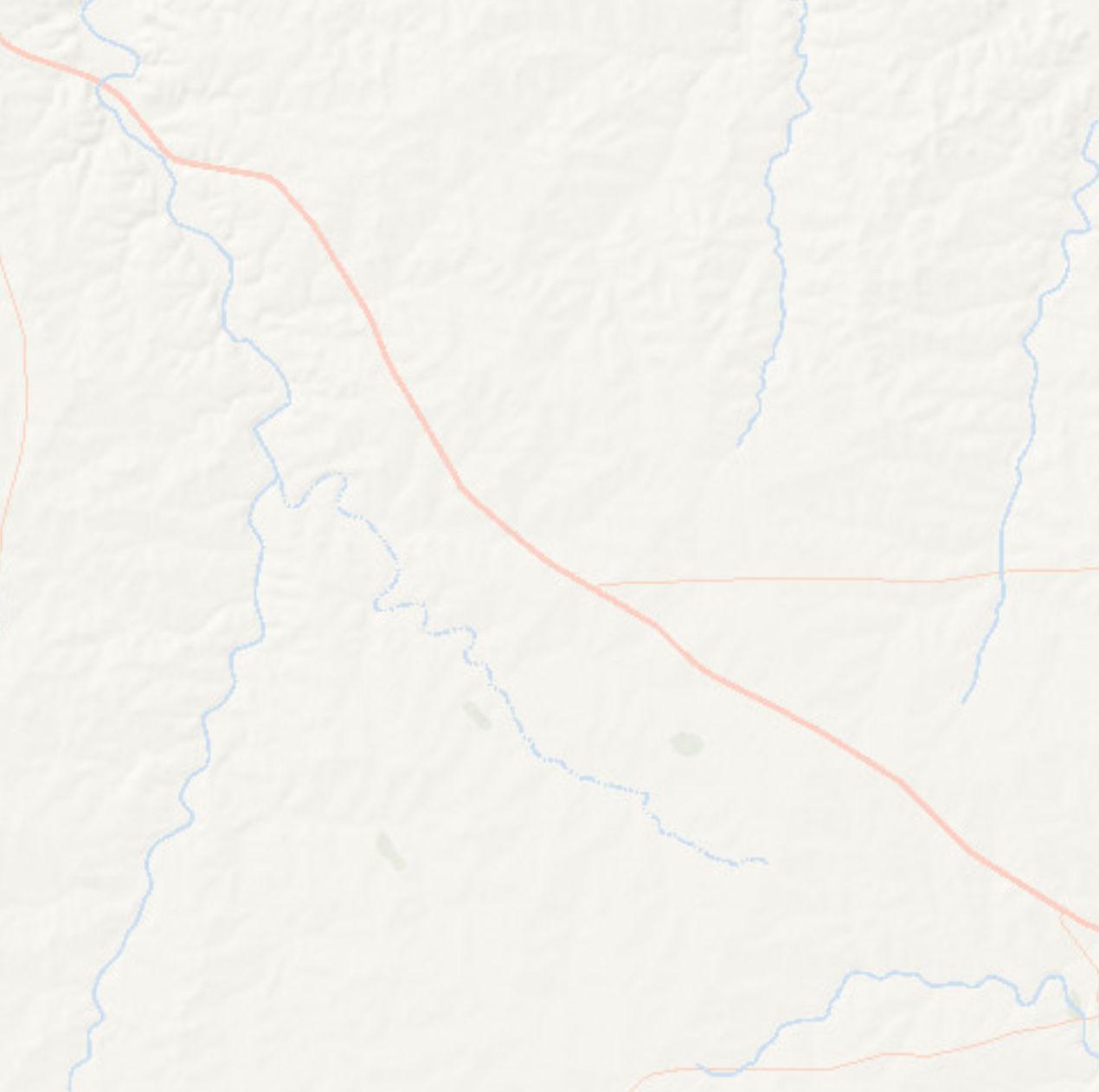





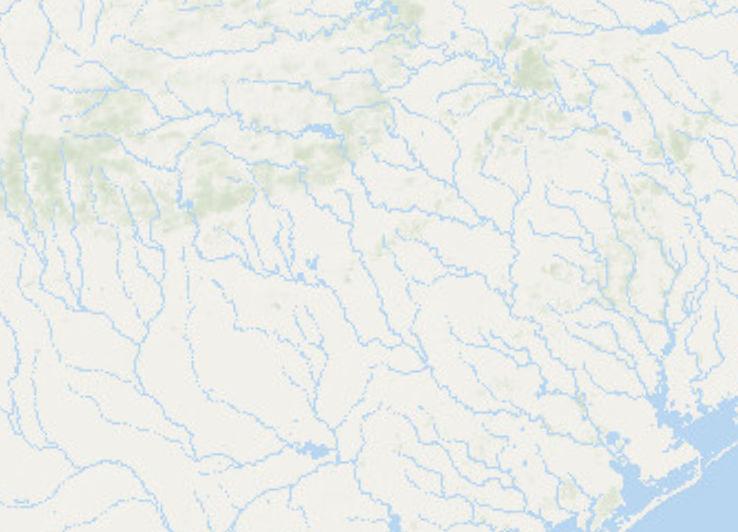

Camp M eeting Creek oG a t C r e e k QuinlanCreek TownCreek Guad a lupe R i ver So uth Fork Guadalupe River Johns on Creek North Fork G uadalupe River 1818 1806A 1818 1806D 1806E 1818 1816 1817 1816 1817 1806 1806 1806 BANDERA KERR REAL KERR KERR GILLESPIE KERR KIMBLE 83 83 27 27 27 27 173 173 39 39 39 41 41 41 16 16 16 10 10 10 10 Ingram K e r r v i l l e 12682 12684 12678 15111 12618 12549 16244 12617 16243 12616 12541 12615 12546
M e e ting Creek 1806A 1806 27 16 K e r r v i l l e USGS Stream Gage Water Quality Monitoring (UGRA) Wastewater Outfall (TCEQ) Major River/Stream Stream Major Roads State Highway (SH) US Highway (US) Interstate Highway (IH) Watershed Boundary County Guadalupe River
Flat Rock Dam
Summary ¯ 0 2.5 5 1.25 Miles DISCLAIMER: The data contained in this map is not survey grade and is provided for informational and reference purposes only. The Guadalupe-Blanco River Authority makes no claim or guarantee for the accuracy or validity of the information presented herein. Guadalupe River Basin 12618 12549 16244 12617 16243 12616 12541 12546 GUADALUPE RIVER ABOVE FLAT ROCK DAM 23 WATERSHED SUMMARIES
Camp
Above
Watershed
Segments
Segment 1818 - South Fork Guadalupe River

Segment 1817 - North Fork Guadalupe River
Segment 1816 - Johnson Creek
Segment 1806 - Guadalupe River Above Canyon Lake
Segment Summaries
The Guadalupe River watershed above Flat Rock Dam consists of several segments, which are described further below. This watershed lies mostly within Kerr County, with a small portion of the drainage basin also covering a portion of southwestern Gillespie County. Soil types in this watershed range from dark and loamy soils over limestone substrate to loam with clay subsoils, which is typical of the Edwards Plateau ecoregion. This watershed falls within the hill country region of Texas; as the name would suggest, this area is characterized by hilly topography and is considered to be the border between the American Southwest and Southeast. Historically this area has been generally rural; however, the scenic views and cool, clear rivers in the area have led to an increase in population and urban sprawl over the years. Swimming, fishing, and kayaking are popular in this watershed. Additionally, there are several summer camps along the banks of the streams throughout this watershed. Many of these camps have lowhead dams (Photo 4) on the river near their property that create swimming holes for the campers.
This watershed is monitored by UGRA. Overall, water quality remains exceptional, and there has been very little change in primary water quality parameters over the last decade.
 Photo 4: Monitoring Water Quality Near a Low-Head Dam in the South Fork Guadalupe River at Hunt Crossing
Photo 4: Monitoring Water Quality Near a Low-Head Dam in the South Fork Guadalupe River at Hunt Crossing
2023 BASIN SUMMARY REPORT 24
Confluence of the North and South Fork Guadalupe River in Kerr County
South Fork Guadalupe River (1818)
South Fork Guadalupe River is a 27-mile-long stream that extends from the confluence with the main stem of the Guadalupe River in Hunt to a point upstream of FM 187 in Kerr County. Segment 1818 is one of the three segments that comprise the headwaters of the Guadalupe River.
Segment 1818 is monitored by Upper Guadalupe River Authority (UGRA) at two stations. No significant increasing or decreasing trends were identified in this segment.
Segment 1818 has concerns for impaired fish, habitat and macrobenthic community. These concerns are thought to be a result of lower than normal flow due to drought conditions during the assessment period. GBRA and UGBRA are conducting Aquatic Life Monitoring Events in these segments to assess if these concerns reflect actual conditions.
M - Meets water quality criteria
I - Impaired for water quality criteria
Table 3: Summary of the 2022 Texas Integrated Report / Segment 1818
North Fork Guadalupe River (1817)
North Fork Guadalupe River is a 29-mile-long stream that extends from the confluence with the main stem of the Guadalupe River in Hunt to a point upstream of Boneyard Draw in Kerr County. Segment 1817 is one of the three segments that comprise the headwaters of the Guadalupe River.
Segment 1817 is monitored by Upper Guadalupe River Authority (UGRA) at one station. No significant trends were identified in this segment.
Segement 1817 has concerns for impaired fish, habitat, and macrobenthic community. These concerns are thought to be a result of lower than normal flow due to drought conditions during the assessment period. GBRA and UGRA are conducting Aquatic Life Monitoring Events in these segments to assess if these concerns reflect actual conditions.
M - Meets water quality criteria
I - Impaired for water quality criteria
Table 4: Summary of the 2022 Texas Integrated Report / Segment 1817
Station ID Dissolved Oxygen Biologicals Bacteria Temperature Nutrients Chlorophyll a 12684 M I M M M M
Station ID Dissolved Oxygen Biologicals Bacteria Temperature Nutrients Chlorophyll a 12682 M I M M M M
25 WATERSHED SUMMARIES
Johnson Creek (1816)
Johnson Creek is a 21-mile-long stream that extends from the confluence with the main stem of the Guadalupe River near Ingram to SH 41 in western Kerr County. Segment 1816 is one of the three segments that comprise the headwaters of the Guadalupe River. The watershed around Johnson Creek is mostly rural with low density urban development and there are a few summer camps upstream of Ingram.
Segment 1816 is monitored by UGRA at one station. Water quality in this segment is exceptional and there has been little variation in water quality parameters over time. Johnson Creek at


M - Meets water quality criteria
C - Concern for water quality criteria
Data analysis from segment 1816 showed that chloride is significantly decreasing and the trend is significantly correlated with flow. Rainfall was below average during the 10-year period of this analysis; decreased runoff could be contributing to this decrease.
Station ID Dissolved Oxygen Biologicals Bacteria Temperature Nutrients Chlorophyll a 12678 M C M M M M
Byas Springs Road
Table 5: Summary of the 2022 Texas Integrated Report / Segment 1816
2023 BASIN SUMMARY REPORT 26
Figure 2: Chloride trend at Station 12678
Guadalupe River Above Canyon Lake (1806)
Guadalupe River above Canyon Lake is a 103-mile-long segment that flows from the confluence between the North and South Forks in Kerr county to Canyon Lake in Comal county. This summary report will divide the segment into two sub-watersheds. For information on the lower 96 miles of this segment, refer to the ‘Guadalupe River below Flat Rock Dam’ chapter. This section will cover the upper seven miles of the segment that flows from the confluence of the North and South Forks to Flat Rock Dam in Kerrville, as well as several tributaries of 1806 including Goat Creek (1806C), Town Creek (1806E), Quinlan Creek (1806D), and Camp Meeting Creek (1806A).
In 2002, segment 1806 was added to the 303(d) list of impaired waters due to bacteria levels above the screening criteria of 126 MPN/100 mL. Portions of segment 1806 contributing to the impairment were determined to be within the urbanized zones of the City of Kerrville. Subsequently, a total maximum daily loading (TMDL) plan was created by UGRA and TCEQ, which was approved by EPA in 2007. The plan aims to reduce bacteria loading through implementation of best management practices (BMPs) in the area. Local stakeholders, including Kerr County and the City of Kerrville, continue to partner with UGRA to implement best management practices first identified in the Bacteria Reduction Plan for the Upper Guadalupe River. More information on the plan can be found at: www.ugra.org/major-initiatives/bacteria-reduction-plan.
Segment 1806 above Flat Rock Dam and its tributaries are monitored by UGRA at nine stations. 1806 above Flat Rock Dam is no longer impaired for bacteria. TMDL implementation and lower than average rainfall, resulting in decreased runoff, could be contributing to the reduction of bacteria levels in this segment. However, three tributaries of segment 1806 are impaired for bacteria, including Camp Meeting Creek (1806A), Quinlan Creek (1806D), and Town Creek (1806E).
Total Maximum Daily Load (TMDL) studies conducted in Quinlan and Town creeks showed that unregulated storm water runoff and bacteria loading from wildlife and livestock are potential contributors to the elevated bacteria levels.
M - Meets water quality criteria
C - Concern for water quality criteria
I - Impaired for water quality criteria
6: Summary of the 2022 Texas Integrated Report / Segment 1806
Station ID Dissolved Oxygen Biologicals Bacteria Temperature Nutrients Chlorophyll a 15111 M I M M M M 12618 M M M M M M 12616 M M M M M M 12617 M M M M M M 16243 M M M M M M 16244 M M M M M M 12615 M M M M M M 12546 C M I M M M 12541 M M I M M M 12549 M M I M M M
Table
27 WATERSHED SUMMARIES
Data analyses indicated that chloride levels significantly decreased over time at multiple sites throughout this segment. Chloride data from station 15111 is shown here (Figure 3). Analyses also showed decreasing sulfate (Figure 4) and nitrate (Figure 5) levels at station 12546. This could be due to annual rainfall amounts during the ten-year period which were mostly below average, leading to decreased surface runoff and reduced chloride and sulfate loading. Communities around Center Point in Kerr County recently transitioned from private septic systems to a public collection system for wastewater, which could also help reduce chloride, sulfate, and nitrate levels.


 Figure 3: Chloride trend at Station 15111
Figure 4: Sulfate trend at Station 12546
Figure 3: Chloride trend at Station 15111
Figure 4: Sulfate trend at Station 12546
2023 BASIN SUMMARY REPORT 28
Figure 5: Nitrate trend at Station 12546







GUADALUPE RIVER BELOW FLAT ROCK DAM BigJoshuaCreek VerdeCreek CypressCreek Blanco River TurtleCreek Guadalupe R iver Guadalupe River 1806 1806 1806 1806 1806 G u a dalupeRiver 1806 1806 Guadalupe River RebeccaCreek 1805A BANDERAKENDALL BANDERA KERR BANDERA KENDALLCOMAL BLANCOCOMAL KENDALL KERR KENDALL GILLESPIE KENDALLBLANCO KENDALL KERR GILLESPIE GILLESPIE BLANCO BEXAR MEDINA MEDINA B E X A R BEXAR COMAL 87 87 281 281 290 290 87 281 27 27 27 27 173 46 46 16 16 173 173 173 46 46 46 16 16 16 16 16 16 16 16 16 16 10 10 10 10 10 10 10 35 281 281 281 281 290 87 87 173 16 211 1604 1604 1604 K e r r v e Garden Ridge Bulverde Blanco Ingram Bandera Boerne Fair Oaks Ranch S a n A n t o n i o Fredericksburg Johnson City 15113 12608 12605 12602 22082 17404 13700 12601 USGS Stream Gage Water Quality Monitoring (GBRA) Water Quality Monitoring (UGRA) Wastewater Outfall (TCEQ) Major River/Stream Stream Major Roads State Highway (SH) US Highway (US) Interstate Highway (IH) Watershed Boundary County Guadalupe River Below Flat Rock Dam Watershed Summary ¯ 0 5 10 2.5 Miles DISCLAIMER: The data contained in this map is not survey grade and is provided for informational and reference purposes only. The Guadalupe-Blanco River Authority makes no claim or guarantee for the accuracy or validity of the information presented herein. Guadalupe River Basin 29 WATERSHED SUMMARIES
Segments
Segment 1806 - Guadalupe River Above Canyon Lake

Segment Summary
The Guadalupe River watershed below Flat Rock Dam includes a portion of segment 1806, Guadalupe River above Canyon Lake. Segment 1806 is a 103-mile-long segment with an 827-squaremile drainage area that flows from the confluence between the North and South Forks in Kerr County to Canyon Lake in Comal County. This summary report will divide the segment into two sub-watersheds; for information on the upper seven miles of this segment, refer to the ‘Guadalupe River above Flat Rock Dam’ chapter. This section will cover the lower 96 miles of the segment that flows from Flat Rock Dam to Canyon Lake.
The Guadalupe River watershed below Flat Rock Dam lies within the Edwards Plateau ecoregion and covers portions of Kerr, Comal, Kendall, and Blanco counties. Soil types in the watershed range from dark and loamy over limestone to loam with clay subsoils. Numerous tributaries flow into this segment of the river including Turtle Creek, Steel Creek, Verde Creek (1806G), Bluff Creek, Cypress Creek (1806B), Holliday Creek, Flat Rock Creek, Block Creek, and Joshua Creek (1806H). This segment of the Guadalupe River is wide and meandering with sections of riffles and rapids. Recreation is popular on this segment of the river; fishing and river tubing are common sights during the warmer months. Land use in this watershed is mostly rural with a few small cities, some unincorporated urban sprawl, and agriculture present.
Segment 1806 is monitored by UGRA at four stations and GBRA at three stations. Data from Station 17404 was used to assess a geometric mean of 140 MPN/100 for E. Coli for this segment, and in 2008 this segment was added to the 303(d) list for non-support of the 126 MPN/100 primary contact recreation standards. Station 22028 was subsequently added to the monitoring schedule in 2019 to provide monitoring upstream of Station 17404. A TMDL was approved for this area in 2007, however no specific BMPs were specifically targeted for this area.
2023 BASIN SUMMARY REPORT 30
Honey Creek at Guadalupe River State Park
M - Meets water quality criteria
C - Concern for water quality criteria
I - Impaired for water quality criteria
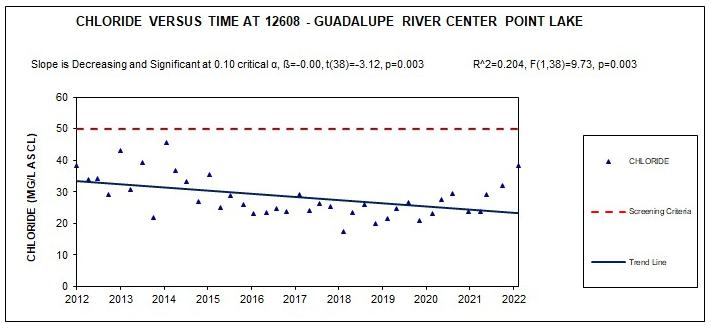
Analysis of data from the stations in this segment showed decreases in chloride and sulfate at several stations. Data from station 12608 for these trends are shown here (Figure 6, Figure 7). This could be due to annual rainfall amounts during the ten-year period which were mostly below average, leading to decreased surface runoff and reduced chloride and sulfate loading.

Station ID Dissolved Oxygen Biologicals Bacteria Temperature Nutrients Chlorophyll a 15113 M C M M M M 12608 M C M M M M 12605 M C M M M M 12602 M C M M M M 22082 M M I M M M 17404 M M I M M M 13700 M M M M M M
Table 7: Summary of the 2022 Texas Integrated Report / Segment 1813
Figure 6: Chloride trend at Station 12608
31 WATERSHED SUMMARIES
Figure 7: Sulfate trend at Station 12608
Total dissolved solids (Figure 8) and turbidity (Figure 9) are also significantly decreasing at station 12608. These decreases are also possibly due to decreased surface runoff from below average rainfall.



At station 15113, a decreasing trend for dissolved oxygen was identified, and E. coli, though still below the screening criteria, had an increasing trend. Both of these trends are likely due to the drought conditions and change in rainfall patterns.
 Figure 10: Dissolved oxygen trend at Station 15113
Figure 11: Log10 E.coli trend at Station 15113
Figure 8: Total dissolved solids trend at Station 12608
Figure 10: Dissolved oxygen trend at Station 15113
Figure 11: Log10 E.coli trend at Station 15113
Figure 8: Total dissolved solids trend at Station 12608
2023 BASIN SUMMARY REPORT 32
Figure 9: Turbidity trend at Station 12608

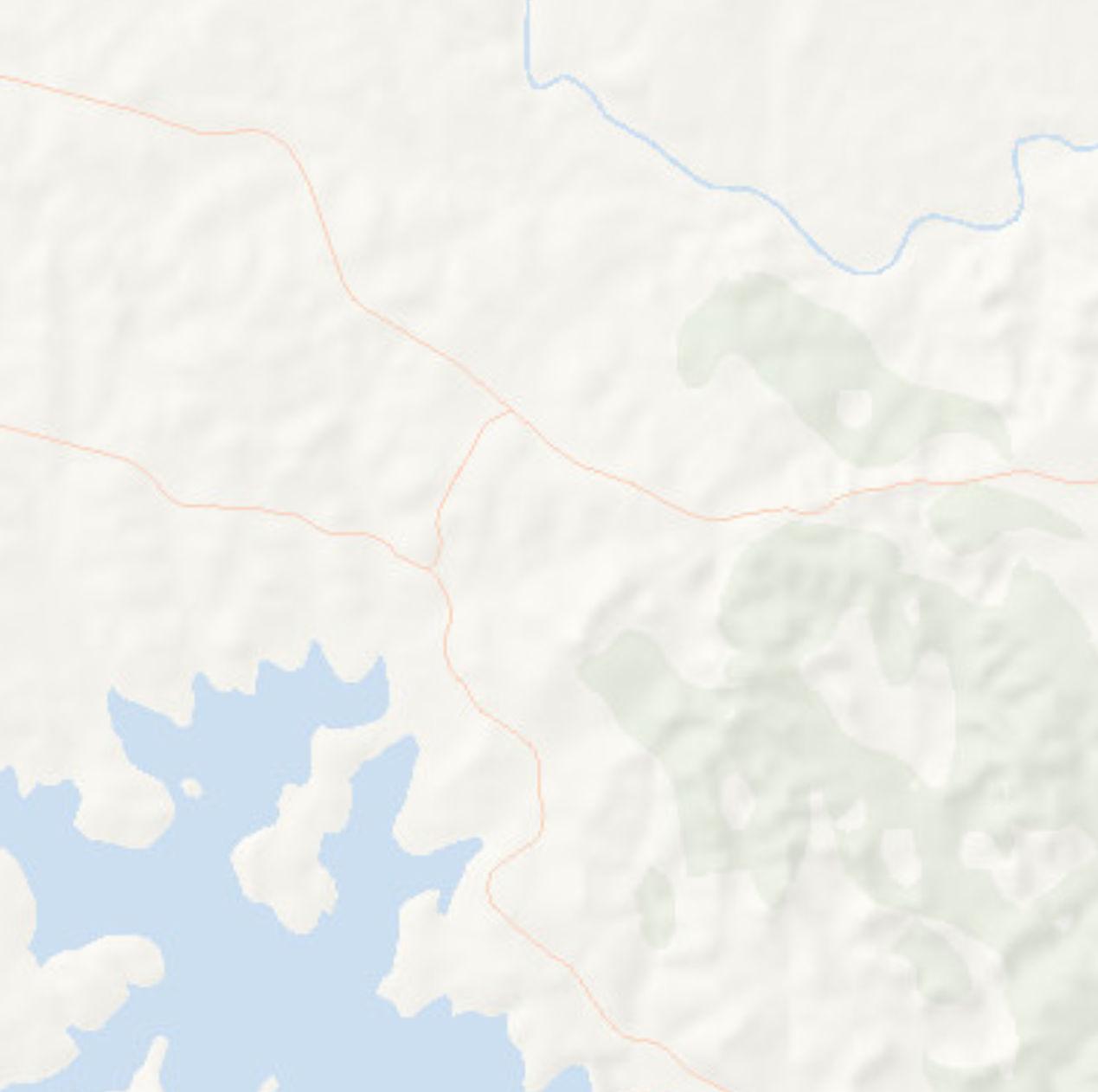
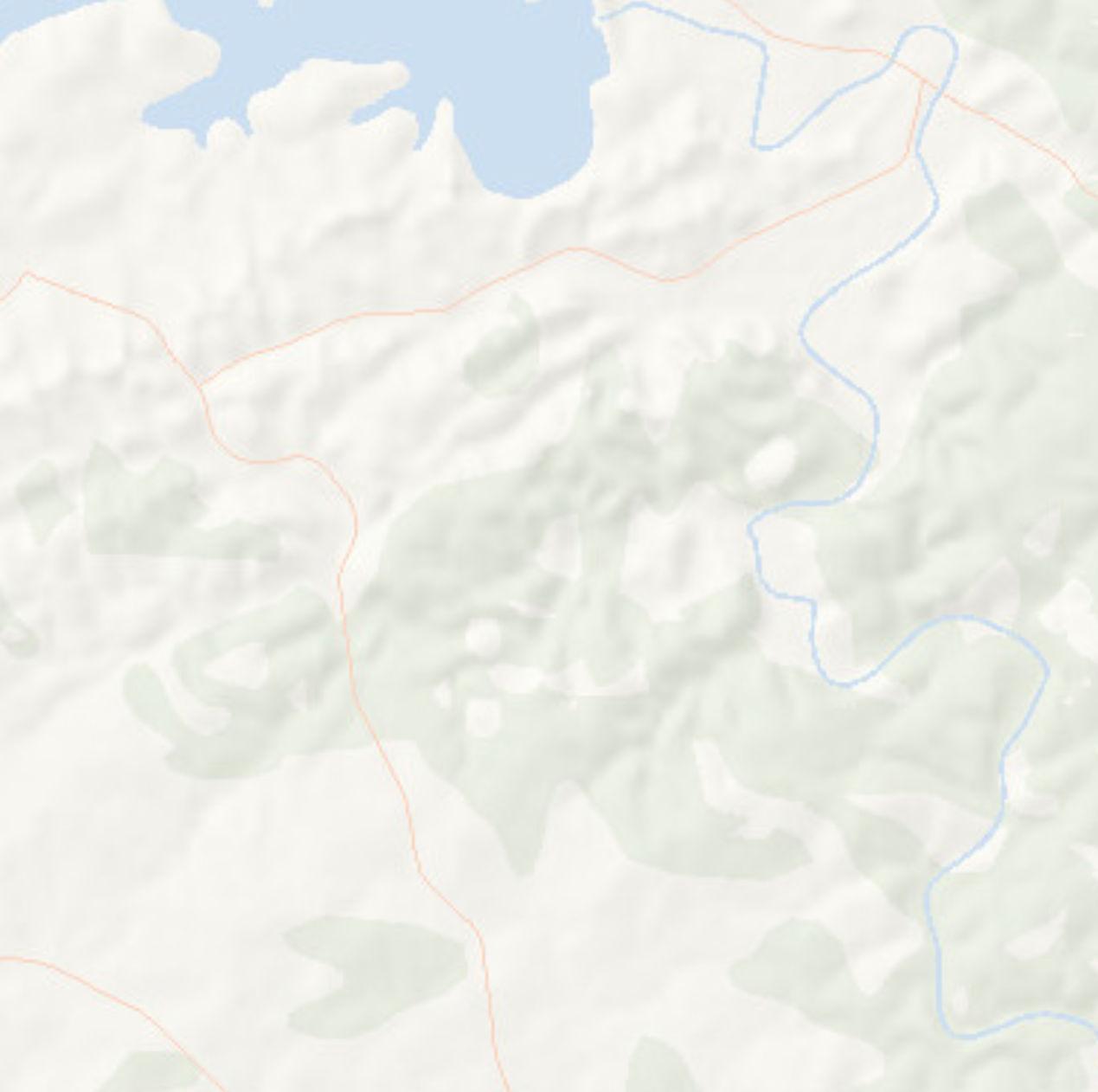




CANYON LAKE D r y C omal Cre ek GuadalupeRiver Blanco River 1806 CanyonLake G u a pulad e R revi RebeccaCreek 1805A 46 12601 12600 12598 12597 USGS Stream Gage Water Quality Monitoring (GBRA) Water Quality Monitoring (TCEQ) Wastewater Outfall (TCEQ) Major River/Stream Stream Major Roads State Highway (SH) US Highway (US) Interstate Highway (IH) Watershed Boundary County Canyon Lake Watershed Summary ¯ 0 1 2 0.5 Miles DISCLAIMER: The data contained in this map is not survey grade and is provided for informational and reference purposes only. The Guadalupe-Blanco River Authority makes no claim or guarantee for the accuracy or validity of the information presented herein. Guadalupe River Basin 33 WATERSHED SUMMARIES
Segments
Segment 1805 - Canyon Lake
Segment Summary
Segment 1805 represents Canyon Lake, a manmade impoundment on the main stem of the Guadalupe River. Canyon Lake has a 1,432-square-mile drainage area. Construction of the Canyon Lake Dam was completed in 1964; this lake has a normal maximum operating level of 909 feet above mean sea level (msl) and a conservation storage capacity of 382,000 acre-feet. Canyon Lake has roughly 80 miles of shoreline and a surface area of 8,240 acres. Substrate in this segment is mostly limestone with areas of dark loam to loam with clay, which is typical of the Edwards Plateau ecoregion. The primary uses of this lake are water storage, flood control, and recreation. Most of the land around the banks of the lake is privately owned, and homes dot the hillsides.
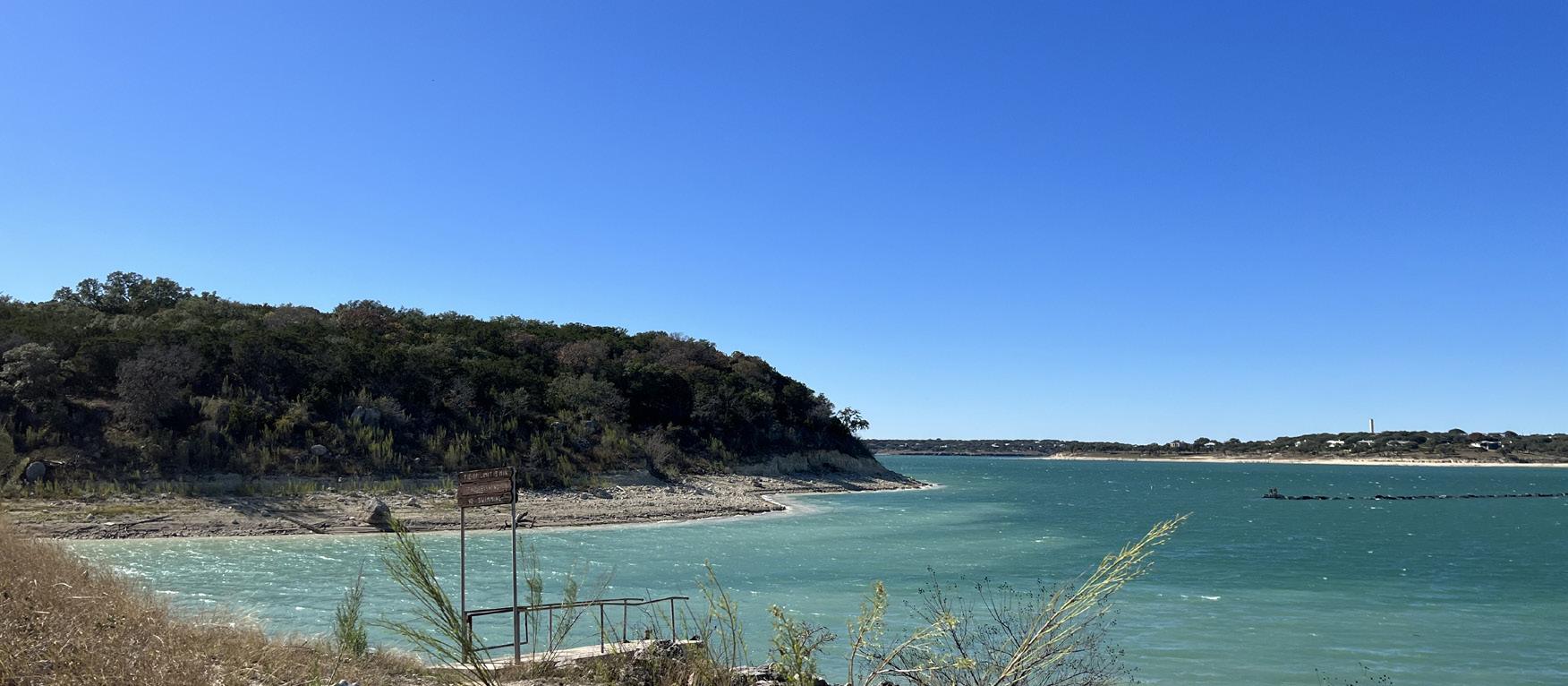
Canyon Lake is operated by two governmental entities. The United States Army Corps of Engineers (USACE) owns the dam and controls the release of flood waters when the pool is above 909 msl. GBRA has the rights to the use and release of water in the conservation pool when the level is between 775 msl to 909 msl. The water is used to supply municipalities, industries, agriculture, and hydroelectric power generation.
The presence of invasive species zebra mussels (Photo 5) was confirmed in Canyon Lake in 2017, after an infested boat was found parked at Crane’s Mill Marina. After this discovery, additional plankton monitoring was conducted in the lake by TPWD and microscopic zebra mussel larvae were found at several locations, confirming a reproducing population. Zebra mussels are highly prolific, and exceedingly efficient filter feeders; one adult zebra mussel can process up to one gallon of water per day. Adult zebra mussels form dense clusters and are able to attach to nearly any surface which can lead to clogged water intake pipes, and hull fouling on boats. Additionally, they are able to outcompete native mussel species for resources. Water clarity tends to increase in lakes that are infested with zebra mussels due to the decrease in plankton. Increased water clarity in Canyon Lake could result in more available habitat
 Canyon Lake
Canyon Lake
2023 BASIN SUMMARY REPORT 34
Photo 5: Zebra Mussels
for another invasive species found in Canyon Lake: hydrilla. Hydrilla has been a popular aquatic ornamental species since the 1960s. In the natural environment, this invasive species occurs at depths up to 15 meters, can grow up to one inch per day, and forms dense mats that crowd out other species and can clog boat propellers.
Segment 1805 is monitored at one station by GBRA and three stations by TCEQ:
M - Meets water quality criteria
I - Impaired for water quality criteria
Table 8: Summary of the 2022 Texas Integrated Report / Segment 1805
Data from TCEQ stations 12597, 12600, and 12601 was not analyzed due to a significant data gap during the assessed period. No significant trends were found at GBRA station 12598.
Canyon Lake has no impairments or concerns for water quality, however there is an impairment for fish consumption in the segment. In 2005, Texas Parks and Wildlife Department (TPWD) collected fish tissue samples from three largemouth bass from Canyon Lake. Results indicated that the samples had a mercury concentration of 0.7 milligrams per kilogram (mg/kg) which is above the human health screening criteria of 0.525 mg/kg. Subsequently, an additional 30 samples were collected from several sport fish species in the lake. All samples collected had detectable levels of total mercury. The mean concentrations for mercury in longnose gar and striped bass were 0.772 mg/kg and 1.149 mg/kg, respectively. As a result of this study, the impairment for mercury in edible fish tissue was added in 2006. The source of the mercury in Canyon Lake has not been confirmed; however, atmospheric deposition from emissions produced by coal-fired power plants and other industries remain the most likely source.
Canyon Lake is monomitic, meaning it experiences one thermal stratification event each year. During the winter months, temperatures throughout the entire depth of the lake are consistent; in the summer months, the lake becomes thermally stratified with a noticeable thermocline between 8 to 10 meters down. When the lake is stratified, water in the epilimnion, or upper layer, becomes warmer and less dense and is unable to mix with the water in the hypolimnion, or lower layer, which is colder and denser. Water in the hypolimnion also tends to become anoxic as organic matter is broken down by bacteria, depleting the available dissolved oxygen. This decline in dissolved oxygen below the thermocline is observed at all monitoring stations in Canyon Lake, trends from station 12601 are shown on the next page:
Station ID Dissolved Oxygen Biologicals Bacteria Temperature Nutrients Chlorophyll a 12597 M I M M M M 12598 M I M M M M 12600 M I M M M M 12601 M I M M M M
35 WATERSHED SUMMARIES


 Figure 12: Spring DO at Station 12601
Figure 13: Summer/Fall DO at Station 12601
Figure 12: Spring DO at Station 12601
Figure 13: Summer/Fall DO at Station 12601
2023 BASIN SUMMARY REPORT 36
Figure 14: Winter DO at Station 12601
Guadalupe River

Below Canyon Dam
Watershed Summary
USGS Stream Gage
Water Quality Monitoring (GBRA)

Wastewater Outfall (TCEQ)
Major River/Stream
Stream
Major Roads
State Highway (SH)
US Highway (US)
Interstate Highway (IH)
Watershed Boundary County




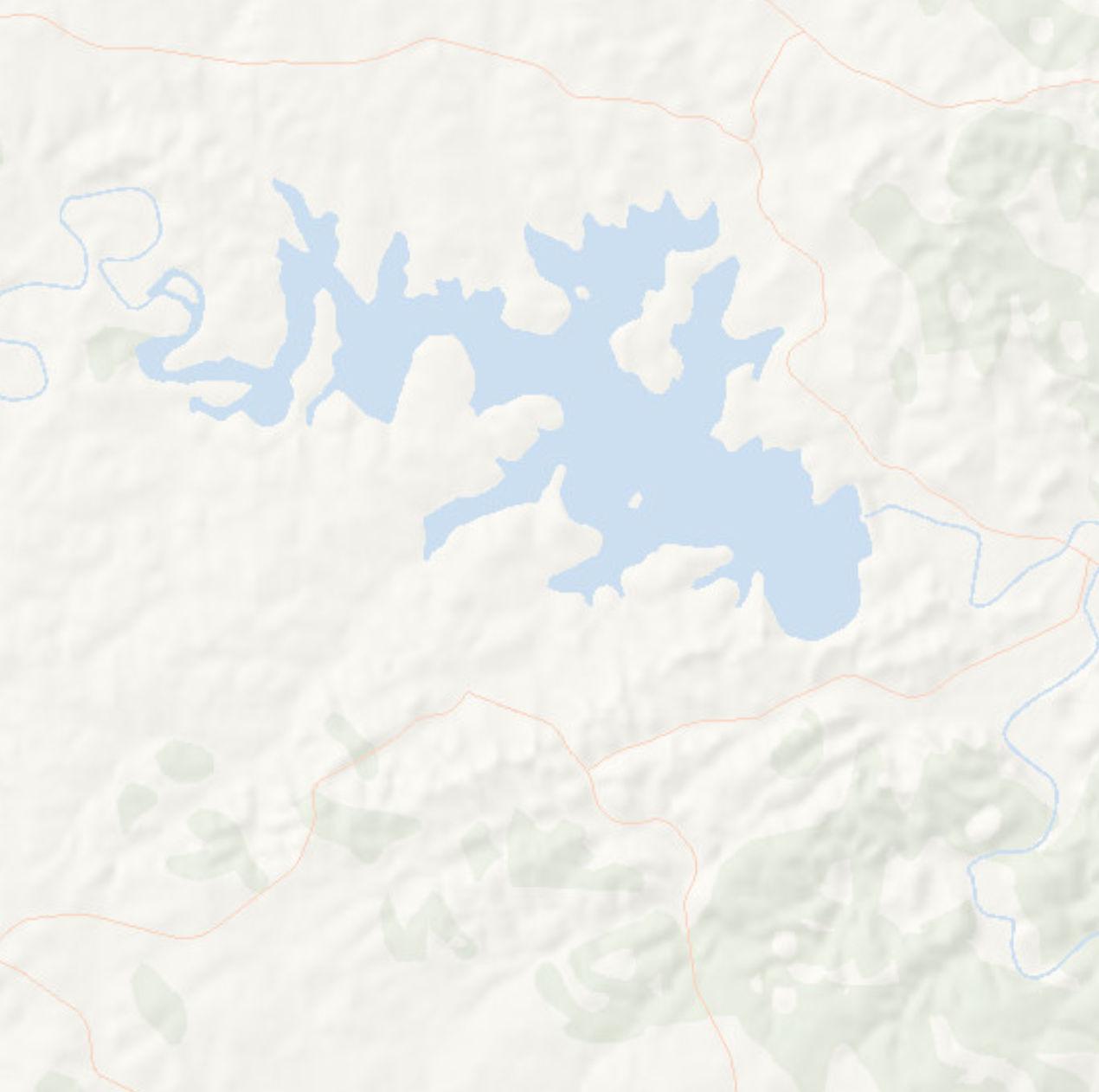
GUADALUPE RIVER BELOW CANYON DAM D r y C omal Cre ek Alligator Creek Dry ComalCreek 1812 1812 1812 Guadalupe River L a k e D u n l a p CanyonLake G u a pulad e R revi GUADALUPE COMAL COMALHAYS 46 80 46 35 35 35 12658 12656 N e w B r a u n f e l s Garden Ridge
¯ 0 1 2 0.5 Miles DISCLAIMER: The data contained in this map is not survey grade and is provided for informational and reference purposes only. The Guadalupe-Blanco River Authority makes no claim or guarantee for the accuracy or validity of the information presented herein.
37 WATERSHED SUMMARIES
Guadalupe River Basin
Segments
Segment 1812 - Guadalupe River Below Canyon

Dam
Segment Summary
Segment 1812 is the stretch of the Guadalupe River that runs from Canyon Dam to the confluence with the Comal River. This segment is 23-miles-long and has a watershed of almost 88-square-miles. This segment lies within the Edwards Plateau ecoregion, and the substrate is predominantly limestone with areas of dark and loamy soil. Water released from the bottom of Canyon Dam is cool and clear, and the segment is known for meandering, slow river runs dotted with areas of whitewater rapids. It is no surprise that this segment is used extensively for contact recreation including tubing, swimming, and fishing. TPWD in conjunction with Trout Unlimited releases rainbow and brown trout in this segment throughout the winter each year for sport fishing. Recreational businesses like river outfitters, campgrounds, and short-term rentals are most common. Due to the rocky soils and limestone escarpments, agricultural practices are not common in this watershed.
GBRA monitors this segment at two stations:
Station ID Dissolved Oxygen Biologicals Bacteria Temperature Nutrients Chlorophyll a 12656 M M M M M M 12658 M M M M M M
M - Meets water quality criteria
Table 9: Summary of the 2022 Texas Integrated Report / Segment 1812
2023 BASIN SUMMARY REPORT 38
Guadalupe River at Second Bridge Crossing
At Station 12656, chloride levels show an increasing trend. Increased chlorides can be a result of diminished flow.
Data analysis at Station 12658 show a significantly decreasing trend in turbidity over the reported period. Segment 1812, and Canyon Reservoir which is immediately upstream, are known for having generally low turbidity. In 2017, it was confirmed that the invasive species zebra mussels had been accidentally introduced to Canyon Reservoir. Zebra mussels are highly efficient filter feeders and have further reduced the turbidity and levels of total suspended solids (TSS) in the reservoir. This likely contributes to the reduced turbidity levels at Station 12658.

 Figure 15: Chloride trend at Station 12656
Figure 15: Chloride trend at Station 12656
39 WATERSHED SUMMARIES
Figure 16: Turbidity trend at Station 12658
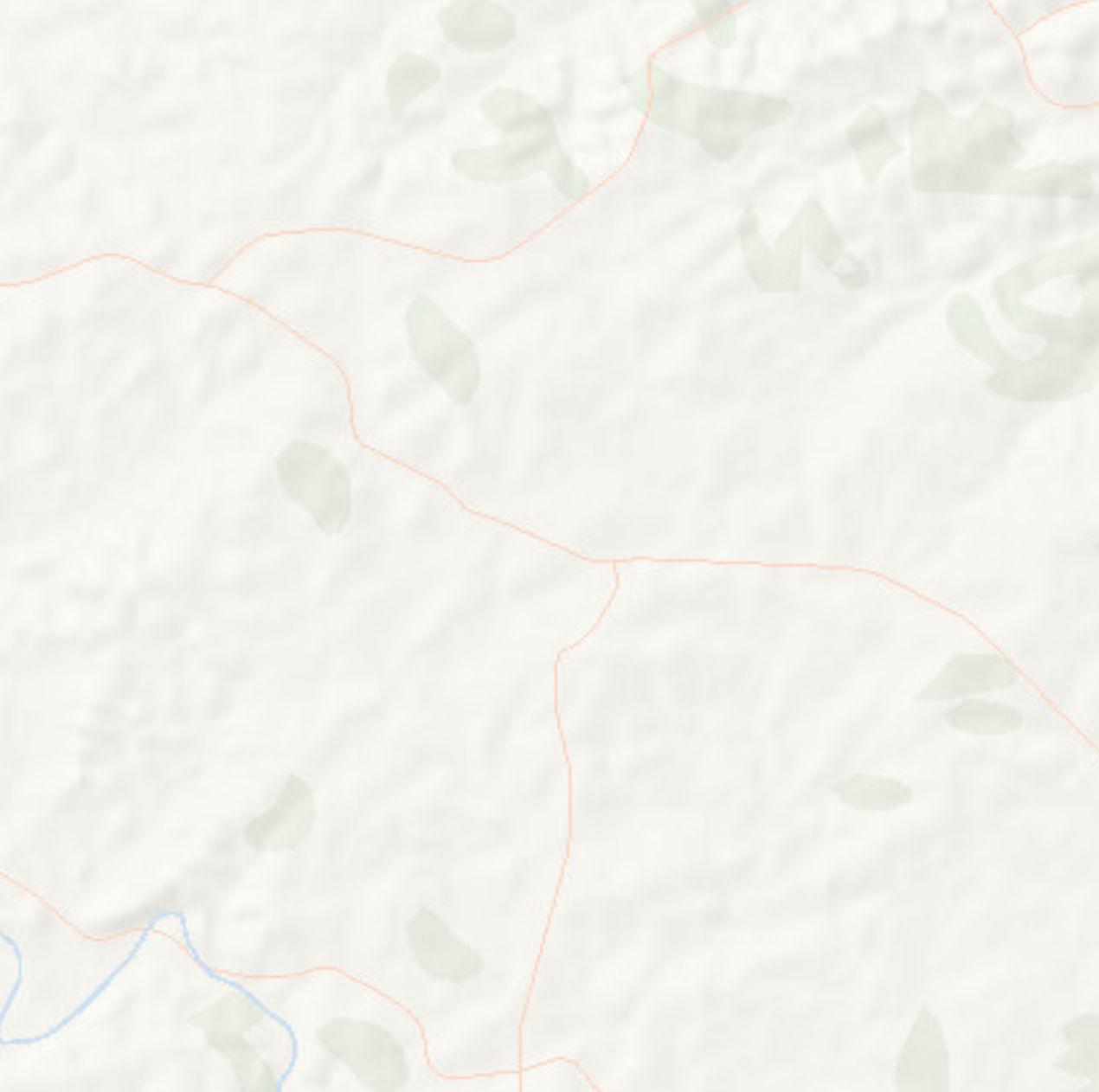
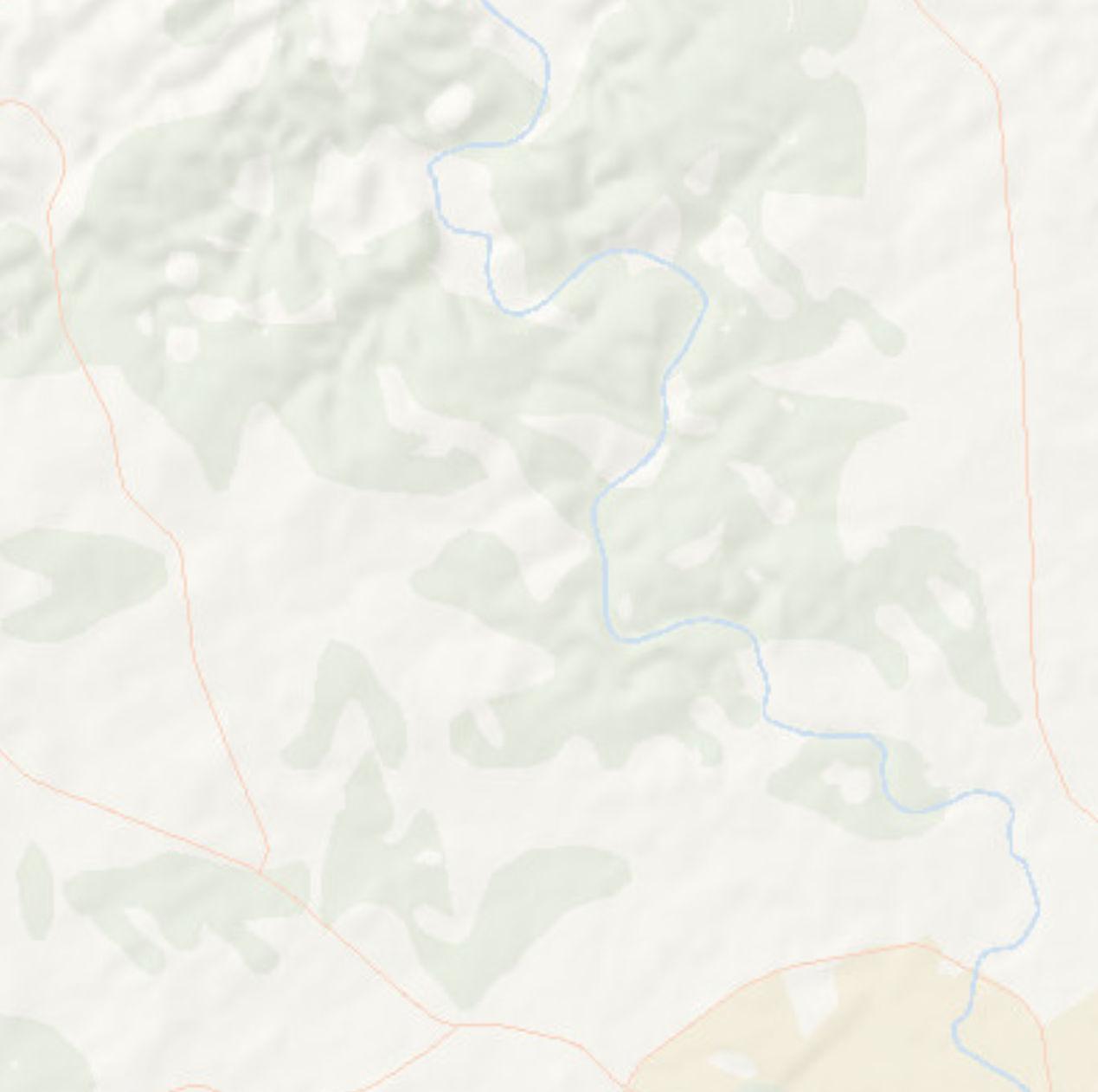

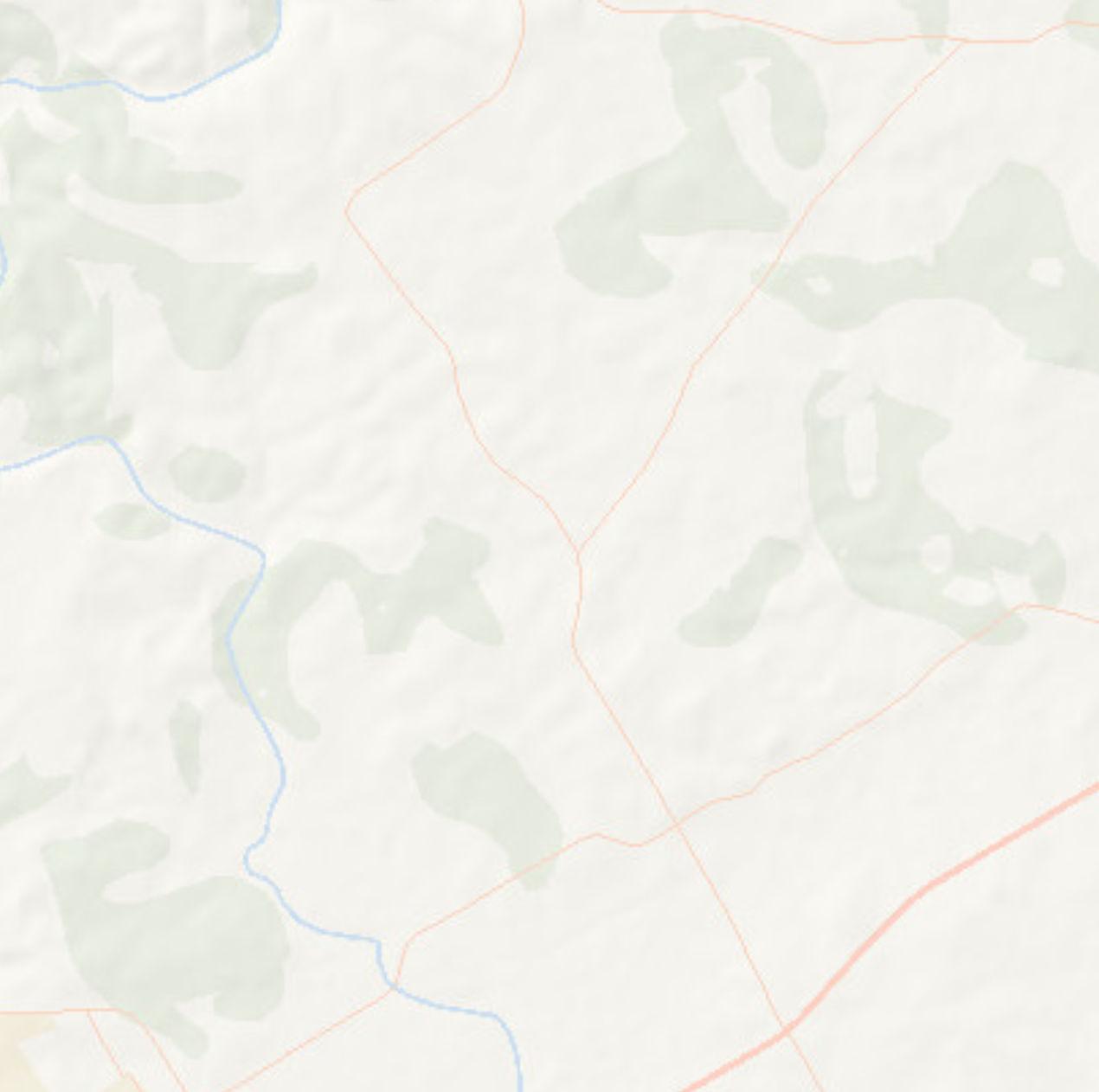


COMAL RIVER Garden Ridge Santa Clara N e w B r a u n f e l s GUADALUPE COMAL D r y C omal Cre ek Dry ComalCreek 1811 1811A 1811A 1811A 46 46 35 15082 12653 12570 USGS Stream Gage Water Quality Monitoring (GBRA) Wastewater Outfall (TCEQ) Major River/Stream Stream Major Roads State Highway (SH) US Highway (US) Interstate Highway (IH) Watershed Boundary County Comal River Watershed Summary ¯ 0 1 2 0.5 Miles DISCLAIMER: The data contained in this map is not survey grade and is provided for informational and reference purposes only. The Guadalupe-Blanco River Authority makes no claim or guarantee for the accuracy or validity of the information presented herein. Guadalupe River Basin 2023 BASIN SUMMARY REPORT 40
Segments
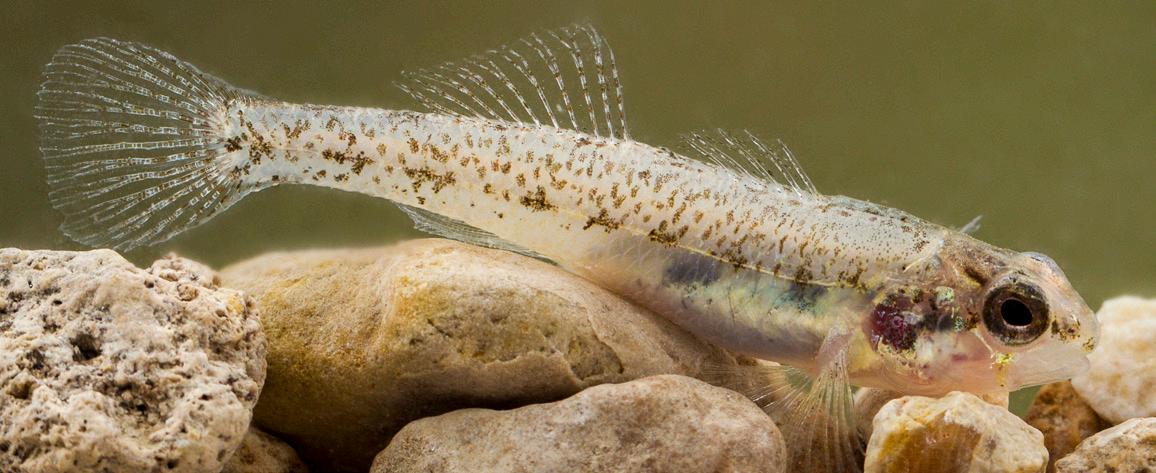

Segment 1811 - Comal River
Segment 1811A - Dry Comal Creek
Segment Summary
At 2.5 miles-long, the Comal River (1811) is the shortest river in the state of Texas and is located entirely within the city limits of New Braunfels in Comal County. This river is fed by Comal Springs, the largest natural spring in Texas based on average discharge, and draws water from the Edwards Aquifer. These springs result in consistent water temperatures, high clarity in the river throughout the year, and provide habitat for several endangered species including the Fountain Darter (Etheostoma fonticola, Photo 7), Comal Springs Riffle Beetle (Heterelmis comalensis, Photo 6), Comal Springs Dryopid Beetle (Stygoparnus comalensis), and the Peck’s Cave Amphipod (Stygobromus pecki). Dry Comal Creek (1811A) is a 34.8-milelong intermittent creek with several pools along the length of the creek. Although a portion of the Dry Comal Creek watershed lies within the City of New Braunfels, the watershed predominantly contains agricultural land and is more rural than land surrounding the Comal River.
In recent years, the Comal River has become an extremely popular destination for river tubing (referred to locally as ‘toobing’, Photo 8), drawing an estimated 300,000 – 400,000 tourists each year from Memorial Day through Labor Day. This heavy recreational use of the river resulted in intense litter pollution in the downstream portion of the river, which was negatively impacting water quality and the ecosystem. This led the city to pass an ordinance banning single use food and beverage containers on the river, which is still currently in effect.
Dry Comal Creek and the lower portion of the Comal River have been impaired for bacteria since 2010 and 2016, respectively. In 2014, the City of New Braunfels secured Clean Water Act 319 funding to develop a Watershed Protection Plan (WPP) for Dry Comal Creek and Comal River to address this impairment. Load duration curves for this watershed recommend a 50% reduction in bacteria loading on the Comal River and a 34% reduction on Dry Comal Creek. A bacterial source tracking study was subsequently performed; results showed that the majority of bacteria
 Photo 6: Riffle Beetle
Photo 7: Fountain Darter
Photo 6: Riffle Beetle
Photo 7: Fountain Darter
41 WATERSHED SUMMARIES
Photo 8: 'Toobers' on the Comal River
in both waterbodies came from wildlife, with additional contributions from livestock, pets, and humans. Following the study, the City of New Braunfels began implementing best management practices (BMPs) in an attempt to reduce bacteria loading. Those BMPs include a city ordinance banning the feeding of wildlife, campaigns to educate residents on the importance of picking up pet waste, and removal of wildlife feces in targeted locations near the river. More information on the WPP is available at: https://newbraunfels.gov/wpp.
GBRA monitors the Comal River at two monitoring stations and the Dry Comal Creek at one monitoring station.
M - Meets water quality criteria
I - Impaired for water quality criteria
Trend analyses performed at station 12653 showed a decreasing trend in sulfate over time (Figure 17), which is inversely correlated with flow.
Improving flow rates following the end of the drought of 2011 could be a contributing factor to the decrease.
A decreasing trend in dissolved oxygen was also found at Station 12653 (Figure 18). Decreasing dissolved oxygen in this segment is typically correlated with a decrease in flow; however, that is not the case here. The reason for this observed decrease in dissolved oxygen is unknown.
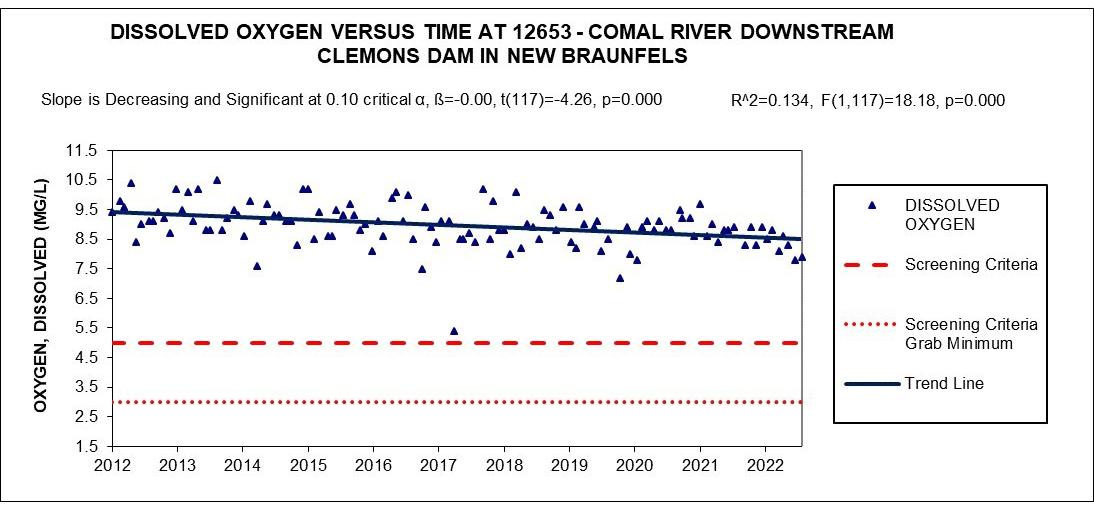

Station ID Dissolved Oxygen Biologicals Bacteria Temperature Nutrients Chlorophyll a 15082 M M M M M M 12653 M M I M M M 12570 M M I M M M
Table 10: Summary of the 2022 Texas Integrated Report / Segment 1811 & 1811A
Figure 17: Sulfate trend at Station 12653
2023 BASIN SUMMARY REPORT 42
Figure 18: Dissolved oxygen trend at Station 12653
At station 12570 (1811A), data analysis shows that nitrate is significantly increasing (Figure 19), which could be due to increased non-point source runoff from agriculture in the watershed.
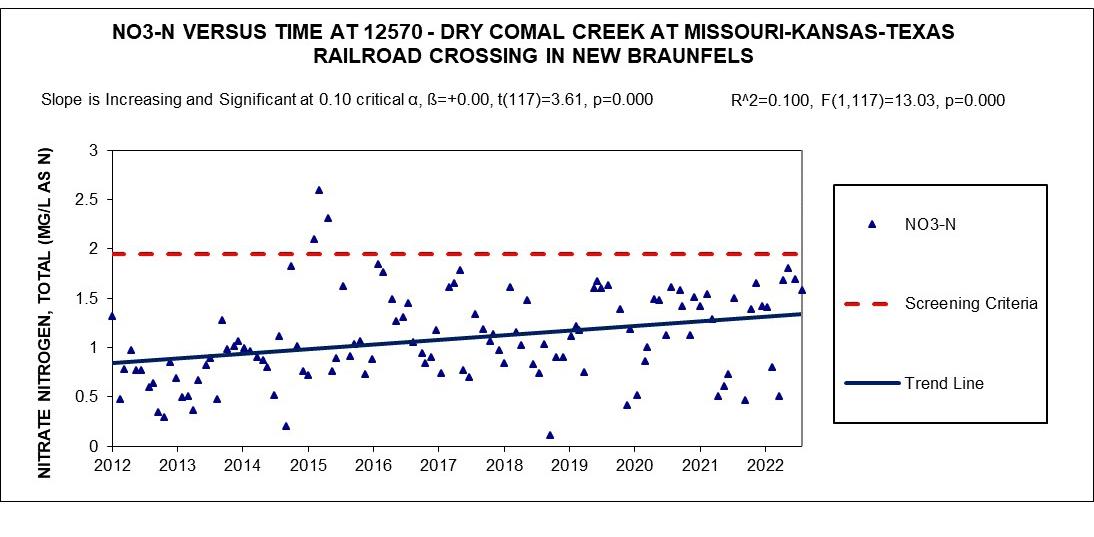
No significant increasing or decreasing trends were identified for E. coli data collected at any of the monitoring stations. However, grab samples collected at station 12570 are consistently reported at or above the screening criteria level of 126 MPN (Figure 20).
 Figure 20: E.coli at Station 12570
Figure 20: E.coli at Station 12570
43 WATERSHED SUMMARIES
Figure 19: Nitrate trend at Station 12570

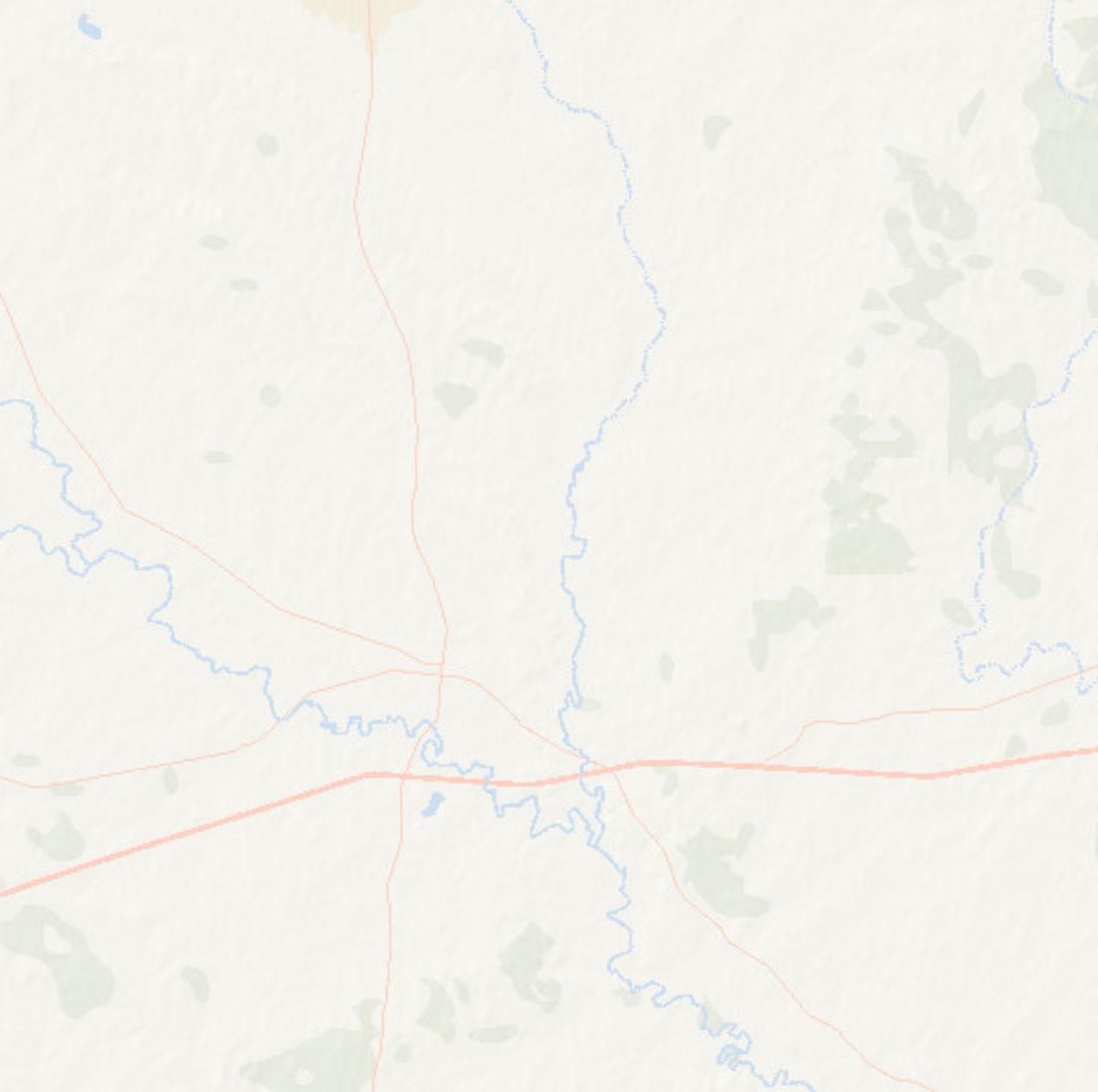
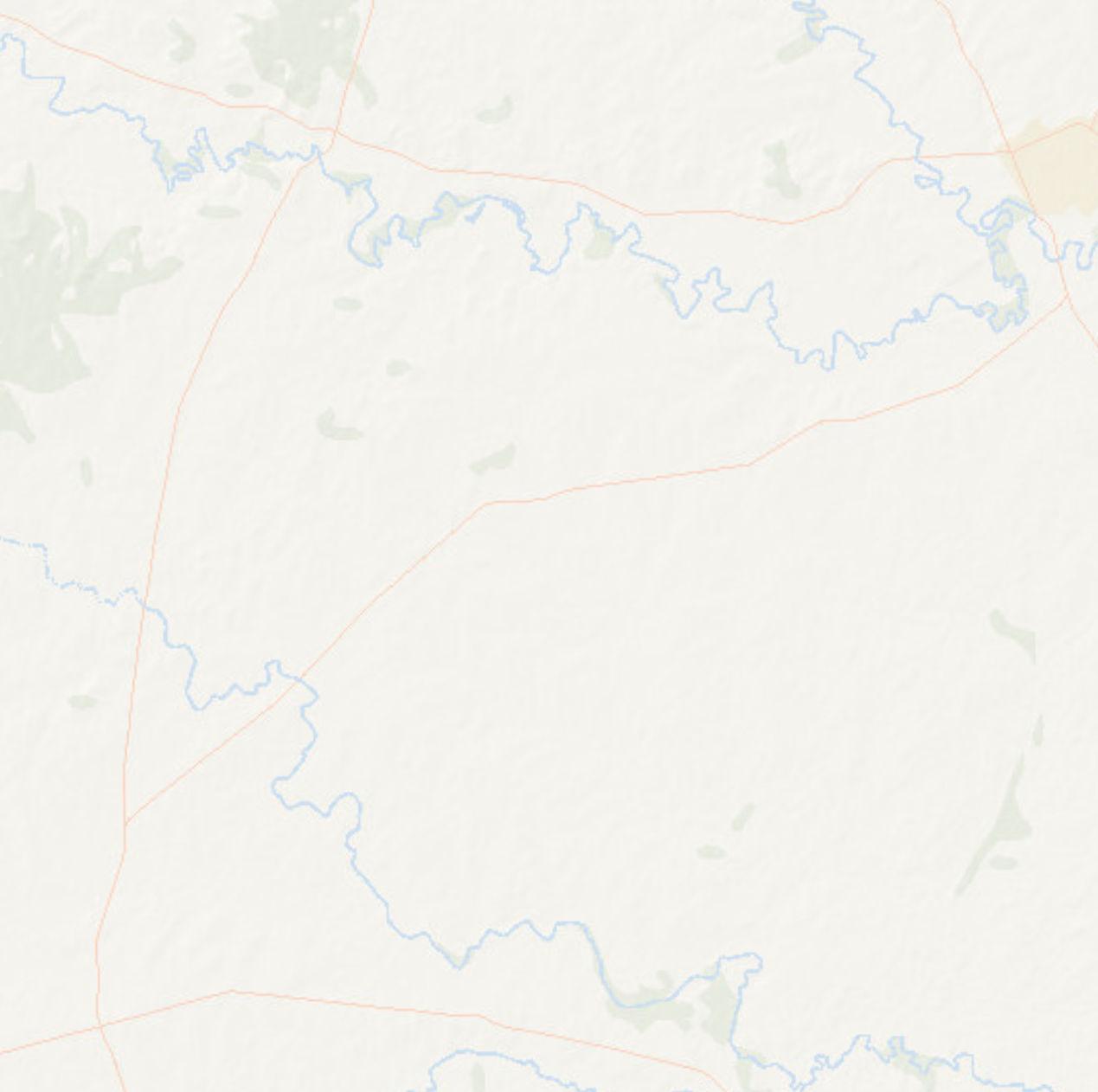



GUADALUPE RIVER BELOW COMAL RIVER Pl um Creek Geronimo Creek SanMarcosRiver San MarcosRi ver GuadalupeRiv er Guad alupe River Sandies Creek SandiesCreek 1804 1804 1804 1804 1804 Lake McQueeney Lake Dun ap Lake Gonzales G u a pulad e R revi WILSONGONZALES GUADALUPEGONZALES GUADALUPE HAYS CALDWELLGONZALES GUADALUPEGONZALES GUADALUPE HAYS COMAL GUADALUPE WILSON 90 183 90 183 90 80 142 80 80 80 97 97 97 80 80 80 46 46 123 123 123 123 123 123 130 130 130 35 10 10 10 10 10 90 183 183 ALT 90 87 87 90 ALT 90 35 90 ALT 90 90 10 ALT 90 87 S e g u i n L o c k h a r t Nixon Luling Gonzales Smiley Staples Martindale N e w B r a u n f e l s 12596 22189 17134 21736 15110 USGS Stream Gage Water Quality Monitoring (GBRA) Wastewater Outfall (TCEQ) Major River/Stream Stream Major Roads State Highway (SH) US Highway (US) Interstate Highway (IH) Watershed Boundary County
Below Comal River
¯ 0 2.5 5 1.25 Miles DISCLAIMER: The data contained in this map is not survey grade and is provided for informational and reference purposes only. The Guadalupe-Blanco River Authority makes no claim or guarantee for the accuracy or validity of the information presented herein. Guadalupe River Basin 2023 BASIN SUMMARY REPORT 44
Guadalupe River
Watershed Summary
Segments
Segment 1804 - Guadalupe River Below Comal River

Segment Summary
Guadalupe River below Comal River is a 101-milelong segment that runs from the confluence of the Comal River in New Braunfels to the confluence with the San Marcos River near Gonzales. Due to the significant hydrological and geological changes that happen in this watershed, this segment is one of the most ecologically diverse in the basin. Segment 1804 flows through the Edwards Plateau, Texas Blackland Prairie, and Post Oak Savannah ecoregions, and lies over the Edwards Balcones Fault Zone and Carrizo Wilcox aquifers. Stream flow in this segment comes from several sources: Canyon Reservoir, spring flows from the Comal River, and several tributaries including Geronimo Creek (1804A). Wastewater discharges between New Braunfels and Seguin also contribute to the total flow. The upper reaches of this segment are urban with a rapidly growing population; as the segment moves south the land use becomes more rural, and agriculture is prevalent. Several different substrate types are found throughout this watershed, including limestone, calcareous clay, sandy loam, clay-loam, dark red sandstone, and tan to gray sandstone.
This segment experiences a 300-foot drop in elevation as it flows south. This elevation change created an ideal location for the construction of six hydroelectric dams to provide power to the surrounding area. The dams were constructed in the 1920s to 1930s and GBRA took ownership in 1963. Unlike Canyon Dam, which is a flood control structure, these are pass-through dams that do not control flood waters. Because of the relatively high velocity of the water flowing through these impoundments (referred to collectively as the Guadalupe Valley Lakes), water quality is significantly different than in larger reservoirs. Stratification, which occurs in Canyon Reservoir, does not occur in these impoundments. Recreation including boating, fishing, and water skiing are extremely popular on the Guadalupe Valley Lakes. The land surrounding Lake Dunlap, Lake McQueeney, and Lake Placid is urban and located in the rapidly expanding I-35 corridor. The watershed surrounding the lower three lakes is more rural. Over time as the dam structures have aged, they have exceeded their useful life expectancy period and are no longer structurally sound. In recent years, several of the structures have failed despite regular maintenance, and replacement of several of the dams is taking place.
45 WATERSHED SUMMARIES
Guadalupe River at H5 Dam
GBRA monitors this segment at five stations:
At station 17134, increasing trends were found for chloride and sulfate. These trends do not have a strong correlation with flow and it is unknown why these trends are increasing. Nonpoint source runoff could be a contributing factor to the observed increases in chloride and sulfate.
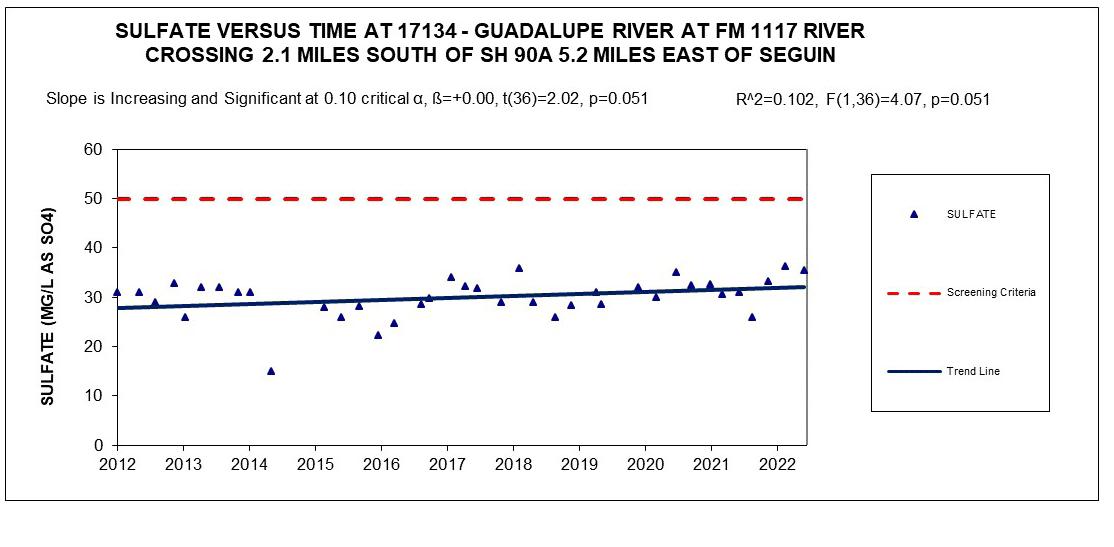

Station ID Dissolved Oxygen Biologicals Bacteria Temperature Nutrients Chlorophyll a 12596 M M M M M M 15110 M M M M M M 17134 M M M M M M 21736 M M M M M M 22189 M M M M M M
M - Meets water quality criteria
Table 11: Summary of the 2022 Texas Integrated Report / Segment 1804
Figure 21: Chloride trend at Station 17134
2023 BASIN SUMMARY REPORT 46
Figure 22: Sulfate trend at Station 17134
A decreasing trend for dissolved oxygen was also found at station 17134. This decrease is not significantly correlated with stream flow. This segment of river is infested with several different species of invasive species which may be contributing to this trend.

An increasing trend in nitrate was identified at station 12596. This station is located on Lake Dunlap, a heavily urbanized area. Fertilizer runoff from lawns that cover a large area of the land directly around the lake could be contributing to this increase. Wastewater effluent could also be contributing to the increase. Education to local homeowners on proper use of fertilizers, and more efficient wastewater treatment could help mitigate this increase.
 Figure 23: Dissolved oxygen trend at Station 17134
Figure 23: Dissolved oxygen trend at Station 17134
47 WATERSHED SUMMARIES
Figure 24: Nitrate trend at Station 12596
Data analysis also showed an increasing trend in E. coli at station 12596. Changes in rainfall patterns could be a contributing factor, as E. coli loading can be higher after a heavy rainfall event that follows a period of drought.

A decreasing trend in chloride was seen at station 15110, which is located in the lower portion of the segment. This trend is inversely correlated with flow.
 Figure 25: Log10 E.coli trend at Station 12596
Figure 25: Log10 E.coli trend at Station 12596
2023 BASIN SUMMARY REPORT 48
Figure 26: Chloride trend at Station 15110
Geronimo Creek

Watershed Summary
USGS Stream Gage
Water Quality Monitoring (GBRA)
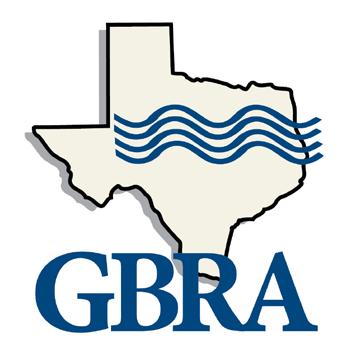
Wastewater Outfall (TCEQ)
Major River/Stream
Stream
Major Roads
State Highway (SH)
US Highway (US)
Interstate Highway (IH)
Watershed Boundary County




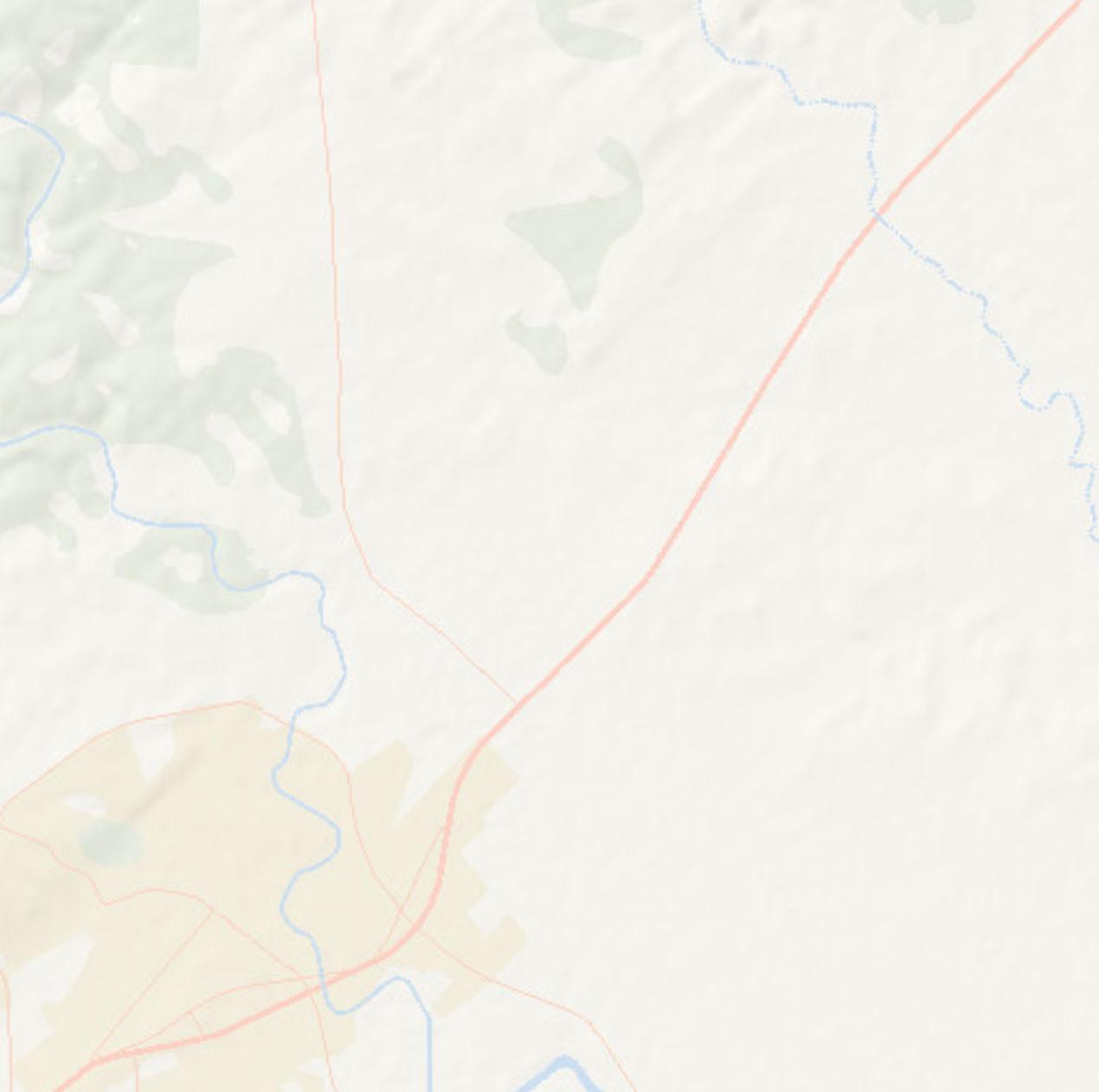
GERONIMO CREEK S e g u i n N e w B r a u n f e l s GUADALUPE HAYS COMAL eB a r erC e k Alligator Creek Geronimo Creek Guad alup e River 1804A 1804A Guadalupe River Lake M c Q u e e n e y L a k e D u n l a p u a pulad e R revi 90 46 46 123 123 130 130 35 10 10 90 ALT 90 12576
¯ 0 1 2 0.5 Miles DISCLAIMER: The data contained in this map is not survey grade and is provided for informational and reference purposes only. The Guadalupe-Blanco River Authority makes no claim or guarantee for the accuracy or validity of the information presented herein.
49 WATERSHED SUMMARIES
Guadalupe River Basin
Segments
Segment 1804A - Geronimo Creek
Segment 1804C - Alligator Creek
Segment 1804D - Bear Creek
Segment Summary
Geronimo Creek is a 17-mile-long tributary of the Guadalupe River located almost entirely within the extra-territorial jurisdictions (ETJ) of the cities of New Braunfels and Seguin. The watershed is roughly 70-square-miles and flows through Comal and Guadalupe counties. Geronimo Creek is a perennial stream with flow sustained by two major springs:
Timmerman Springs and an unnamed spring issuing from the Leona Aquifer through alluvium substrate. Geronimo Creek watershed lies within the IH-35 corridor and is experiencing a major population boom. For several years, the city of New Braunfels has been among the fastest growing cities in the nation, which creates concerns for increased nonpoint source pollution and challenges in providing water to an increasing population.
Geronimo Creek was first added to the 303(d) List of Impaired Water Bodies for bacteria in 2006. In 2009, the TSSWCB, GBRA, and Texas A&M AgriLife Extension began developing a Watershed Protection Plan (WPP) for the watershed; this plan was accepted by EPA in 2012. One station (12576) is monitored in Geronimo Creek under the Clean Rivers Program. Extensive additional monitoring is conducted under the Geronimo and Alligator Creeks Watershed Protection Plan, including seven routine sites, four weather targeted sites, one spring, and two wells. Alligator Creek (1804C) and Bear Creek (1804D) are not monitored under the Clean Rivers Program but are monitored under the WPP monitoring program. More information on the WPP and water quality data collected under that program is available at http://www.geronimocreek.org/.
Geronimo Creek remains impaired for bacteria, and has a concern for nitrate nitrogen. Additionally, Bear Creek (1804D) also has a concern for bacteria. In 2015, a study was conducted by the United States Geological Survey to characterize the sources of elevated nitrate nitrogen concentrations on Geronimo Creek and the underlying Leona Aquifer. The report stated that the sources of the nitrates in the groundwater and springs are most likely from diffuse sources that occur in conjunction with the mixing of nitrate from fertilizer applications and septic systems. Best management practices, including nutrient management training, identifying and decommisioning failing septic systems, and storm water management were recommended under the WPP.

2023 BASIN SUMMARY REPORT 50
GBRA Water Quality Team Conducting Flow Measurement on Geronimo Creek
M - Meets water quality criteria
C - Concern for water quality criteria
I - Impaired for water quality criteria
No significant increasing or decreasing trends were found in data assessed at station 12576. Results from bacteria grab samples remain consistently near or above the screening criteria of 126 MPN (Figure 27). The 2022 Texas Integrated Report lists a bacteria geometric mean of 214.21 MPN for Geronimo Creek. In 2019, a bacterial source tracking study was completed on Geronimo Creek. Data were collected at two sites: Geronimo Creek at Haberle Road (12576) and Geronimo Creek at Seguin Outdoor Learning Center (21261), which is a site monitored under the WPP. Results from the study indicated that the largest contributors of bacteria at these sites were avian and non-avian wildlife, followed by livestock. Humans had a relatively low impact, accounting for only 2% and 3% of bacteria detected at the two stations, respectively. Future best management practices should focus on runoff reduction as well as wildlife and livestock management to reduce bacteria loading.
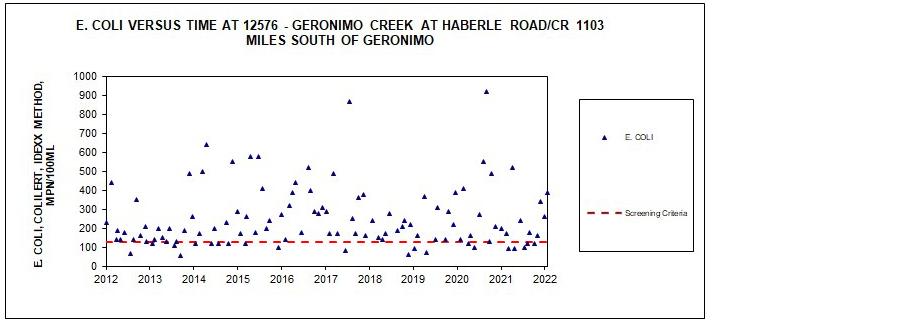
Station ID Dissolved Oxygen Biologicals Bacteria Temperature Nutrients Chlorophyll a 12576 M M I M C M
Table 12: Summary of the 2022 Texas Integrated Report / Segment 1804A
51 WATERSHED SUMMARIES
Figure 27: E.coli at Station 12576







BLANCO RIVER Bgi erC ek Falls Creek KochCreek Cotton w o o d Cree k B l a n oc R v er Crab a pple Creek C ypressCreek Blanco River Blanco R ver PlumCreek Blanco River Blanco River 1 809 1 815 1813 1813 1813 1813 CanyonLake 1813 N e w B r a u n f e l s K y e S a n M a r c o s Wimberley Bulverde Blanco Buda Woodcreek Mountain City Boerne Fair Oaks Ranch Johnson City BLANCOCOMAL KENDALLBLANCO BLANCOHAYS COMALHAYS 281 290 281 290 281 46 80 80 21 46 46 46 123 123 10 35 35 35 35 281 281 281 12669 12668 12665 12677 22109 22110 12676 12675 12674 12673 12661 12663 12660 12635 12631 21804 Water Quality Monitoring (GBRA) Water Quality Monitoring (WVWA) Water Quality Monitoring (MCWE) Water Quality Monitoring (TCEQ) USGS Stream Gage Wastewater Outfall (TCEQ) Major River/Stream Stream Major Roads State Highway (SH) US Highway (US) Interstate Highway (IH) Watershed Boundary County Blanco River Watershed Summary ¯ 0 5 10 2.5 Miles DISCLAIMER: The data contained in this map is not survey grade and is provided for informational and reference purposes only. The Guadalupe-Blanco River Authority makes no claim or guarantee for the accuracy or validity of the information presented herein. Guadalupe River Basin Wimberley Woodcreek 12677 22109 22110 12676 12675 12674 12673 12661 21804 12660 12663 2023 BASIN SUMMARY REPORT 52
Segments
Segment 1813 - Upper Blanco River
Segment 1809 - Lower Blanco River
Segment 1815 - Cypress Creek
Segment Summaries
Upper Blanco River (1813)
Upper Blanco River is a 71-mile-long segment that flows through Kendall and Blanco counties before transitioning into the Lower Blanco River (1809). This segment lies within the Edwards Plateau; the upper portion of this segment is characterized by gaining and losing stretches and regularly goes dry during times of low rainfall. The lower portion of the stream is spring fed and more perennial. Substrate in this segment are mostly limestone, with the occasional gravel, silt, or clay. The limestone substrate is known to contain gypsum deposits, which is a potential contributor of high sulfate concentrations in ground water in the area. Segment 1813 has numerous tributaries, including Cypress Creek (1815).
MCWE Staff collecting data on the Upper Blanco River

Upper Blanco River exhibits exceptional water quality and has no concerns or impairments as of the 2022 Texas Integrated Report. The cool, clear waters of the Blanco River attract many recreationalists each year; tubing, kayaking, swimming, and fishing are popular on the Blanco. Like many other areas in the hill country region, the watershed around segment 1813 is experiencing a population increase, which could lead to increased non-point source pollution through runoff as the amount of impervious cover increases.
Segment 1813 is monitored by Wimberley Valley Watershed Association (WVWA) and TCEQ at six stations, located throughout the segment.
Station ID Dissolved Oxygen Biologicals Bacteria Temperature Nutrients Chlorophyll a 12660 M M M M M M 12661 M M M M M M 12663 M M M M M M 12665 M M M M M M 12668 M M M M M M 12669 M M M M M M
M - Meets water quality criteria
53 WATERSHED SUMMARIES
Table 13: Summary of the 2022 Texas Integrated Report / Segment 1813
Data analyses indicate a decreasing trend for total suspended solids (TSS) at all stations in segment 1813. Data from station 12665 is shown here (Figure 28). Some stakeholders have hypothesized that the decrease could be due to more efficient treatment of wastewater upstream or due to a decrease in the amount of construction happening near the river.

Analyses also show a decreasing trend for E. coli at several sites in segment 1813, including 12663, 12665, and 12668. Data from 12665 are shown here (Figure 29). Other notable trends at station 12668 include increasing trends in sulfate (Figure 30) and chloride (Figure 31), and a decreasing trend in chlorophyll a (Figure 32). These trends may be a result of decreased runoff due to a lower than average rainfall and as a result, a proportionally larger influence from groundwater.
 Figure 28: TSS trends at Station 12665
Figure 28: TSS trends at Station 12665
2023 BASIN SUMMARY REPORT 54
Figure 29: E.coli trend at Station 12665


 Figure 30: Sulfate trend at Station 12668
Figure 31: Chloride trend at Station 12668
Figure 30: Sulfate trend at Station 12668
Figure 31: Chloride trend at Station 12668
55 WATERSHED SUMMARIES
Figure 32: Chlorophyll a trend at Station 12668
Cypress Creek (1815)
Cypress Creek at Ranch Road 12

Cypress Creek is a 15.7-mile-long, spring-fed creek with a 38.3-square-mile drainage area. Cypress Creek flows through the City of Wimberley before joining the Blanco River. This stream has been known for exceptional water quality and is a popular area for recreational activity. Several natural swimming holes, including Jacobs Well and Blue Hole, that dot the length of this creek are popular tourist attractions during the warmer months.
In 2014, a Watershed Protection Plan (WPP) was developed for Cypress Creek. This plan was originally meant to serve as a proactive plan to address likely future impairments in the watershed. In 2020, segment 1815 was added to the 303(d) list of impaired water bodies for impaired fish community and impaired macrobenthic community. Aging and failing septic systems are thought to be one of the contributing factors to the decrease in water quality in the creek. Other potential contributors include wildlife. A bat colony that lives under the RR 12 bridge in downtown Wimberley is believed to be a potential source of bacteria. Though not currently impaired for bacteria, this parameter is of concern for local stakeholders. More information about the WPP is located at: https://www.cypresscreekproject.net/.
There are currently six monitoring stations in 1815 monitored by WVWA, and one station monitored by GBRA (station 12674).
M - Meets water quality criteria
C - Concern for water quality criteria
I - Impaired for water quality criteria
Table 14: Summary of the 2022 Texas Integrated Report / Segment 1815
Station ID Dissolved Oxygen Biologicals Bacteria Temperature Nutrients Chlorophyll a 12673 C I M M M M 12674 C I M M M M 12675 C I M M M M 12676 C I M M M M 12677 C I M M M M 22109 M M M M M M 22110 M M M M M M
2023 BASIN SUMMARY REPORT 56
Total dissolved solids (TDS) at station 12677 are significantly increasing (Figure 33). Stream flow at this site has decreased over time, resulting in a larger proportion of the flow at this site coming from ground water out of Jacobs Well. Data from the USGS station located several feet down in Jacobs Well shows increased levels of TDS compared to data collected at Station 12677 (Figure 34), which suggests that this could be a contributing factor.
Analysis also showed a decreasing trend for TSS (Figure 35) at station 12675. The reason for this decrease is unknown.


 Figure 33: Total dissolved solids trends at Station 12677
Figure 34: Total dissolved solids data compared with calculated TDS from USGS data at Station 12677
Figure 33: Total dissolved solids trends at Station 12677
Figure 34: Total dissolved solids data compared with calculated TDS from USGS data at Station 12677
57 WATERSHED SUMMARIES
Figure 35: Total suspended solids trend at Station 12674
Lower Blanco River (1809)

Lower Blanco River is a 16-mile-long stretch of river that begins southeast of Kyle and flows south to the confluence with the San Marcos River. Like the Upper Blanco River, this segment lies mostly within the Edwards Plateau but transitions into the Blackland Prairie Ecoregion in the eastern portion of Hays County. Farming and ranching have traditionally been common land uses in this segment; however, the area is experiencing a shift toward more urban development as the nearby cities of Kyle and San Marcos continue to experience rapid population growth. Segment 1809 is monitored quarterly by TCEQ at two stations.
M - Meets water quality criteria
Table 15: Summary of the 2022 Texas Integrated Report / Segment 1809
At station 12631, analysis showed an increasing trend in chloride and sulfate. These trends could be a result of upstream concentrations, or from runoff from the surrounding cities. Another potential source is interactions with geologic formations high in saline deposits.

Station ID Dissolved Oxygen Biologicals Bacteria Temperature Nutrients Chlorophyll a 12631 M M M M M M 12635 M M M M M M
Figure 36: Chloride trends at Station 12631
2023 BASIN SUMMARY REPORT 58
Figure 37: Sulfate trends at Station 12631







SAN MARCOS RIVER S e g u i n L o c k h a r t N e w B r a u n f e l s K y l e S a n M a r c o s Luling Gonzales Wimberley Uhland Staples Santa Clara Woodcreek Mountain City Niederwald Creedmoor GUADALUPE HAYS COMALHAYS CALDWELLGONZALES GUADALUPEGONZALES B l a n oc R i v er Pl um Creek Blanco River SanMarcosRiver San MarcosRi ver P lumCreek P um Creek Blanco River GuadalupeRiv er Guad alupe River 1814 1808 1808 1808 1808 Guadalupe River Lake McQueeney Lake Dunlap 1808 Lake Gonzales SinkCreek Purgatory Creek YorkCreek Seal s C r e e k G u a pulad e R revi 90 183 183 183 80 80 142 142 80 80 80 97 97 80 80 21 21 21 46 46 123 123 123 123 130 130 130 130 130 35 10 10 10 10 10 90 35 183 183 ALT 90 90 ALT 90 35 90 ALT 90 90 35 10 ALT 90 12672 12628 12626 16578 USGS Stream Gage Water Quality Monitoring (GBRA) Water Quality Monitoring (TCEQ) Wastewater Outfall (TCEQ) Major River/Stream Stream Major Roads State Highway (SH) US Highway (US) Interstate Highway (IH) Watershed Boundary County San Marcos River Watershed Summary ¯ 0 2.5 5 1.25 Miles DISCLAIMER: The data contained in this map is not survey grade and is provided for informational and reference purposes only. The Guadalupe-Blanco River Authority makes no claim or guarantee for the accuracy or validity of the information presented herein. Guadalupe River Basin 59 WATERSHED SUMMARIES
Segments
Segment 1814 - Upper San Marcos River
Segment 1808 - Lower San Marcos River
Segment Summary
Upper San Marcos River (1814)
Upper San Marcos River is a 4.5-mile-long, spring-fed stream that flows through Hays and Guadalupe counties before joining the Lower Guadalupe River in Gonzales County. This segment lies within the Edwards Plateau and has primarily limestone substrate. The Upper San Marcos River is known for its exceptional water quality and is a popular river for recreational activities including tubing, kayaking, swimming, and fishing. The upper portions of the river are also home to several endangered and endemic species including the Fountain Darter (Etheostoma fonticola), Texas Blind Salamander (Typhlomolge rathbuni), and Texas Wild Rice (Zizania texana).
In 2010, the Upper San Marcos River was listed on the 303(d) list of impaired water bodies for total dissolved solids (TDS). Analysis of data collected between 2002 and 2016 showed a significant positive correlation between TDS and flow, suggesting that increased runoff could be contributing to elevated TDS concentrations. Currently, the Upper San Marcos River has no concerns or impairments.
Development of the Upper San Marcos Watershed Protection Plan (WPP) began in 2012, and the WPP was accepted by EPA in 2018. The goals of the WPP are to educate the public on water quality issues and to implement best management practices in the watershed. Projects under this WPP include erosion control and improved biofiltration ponds to improve stormwater management, restoration of natural areas in the watershed, and construction of vegetated filter strips and brush berms to reduce runoff. More information about the WPP can be found at https://www. uppersanmarcosriver.org/. Segment 1814 is monitored under the Clean Rivers Program quarterly at one monitoring station, located at the IH-35 bridge crossing.

Station ID Dissolved Oxygen Biologicals Bacteria Temperature Nutrients Chlorophyll a 12672 M M M M M M M - Meets water quality criteria Table
2023 BASIN SUMMARY REPORT 60
Texas Wild Rice (Credit: Nick Breaux)
16: Summary of the 2022 Texas Integrated Report / Segment 1814
Analysis of data from station 12672 showed increasing trends in sulfate (Figure 38) and chloride (Figure 39). These increases were not significantly correlated with flow. It is unclear what is causing these increases, however runoff could be a contributing factor.

 Figure 38: Sulfate trend at Station 12672
Figure 38: Sulfate trend at Station 12672
61 WATERSHED SUMMARIES
Figure 39: Chloride trend at Station 12672
Lower San Marcos River (1808)
The Lower San Marcos River is a roughly 70-mile-long stretch of river that runs from the confluence with the Blanco River down to the confluence with the main stem of the Guadalupe River. The upper portion of this segment features swift moving, clear water that flows over the limestone substrate of the Edwards Plateau. This segment transitions into a slower moving, more turbid river as it passes over the black clays of the Texas Blackland Prairies ecoregion. While the upper portion of segment 1808 is urban and experiencing a large increase in population, the majority of this watershed lies within more rural areas of Caldwell and Gonzales counties. Agriculture and ranching are common, and oil and gas activity is a common occurrence. This segment is monitored by GBRA and TCEQ at three stations spread throughout the segment.
M - Meets water quality criteria
I - Impaired for water quality criteria
At station 12628, data analysis showed increasing trends in chloride (Figure 40) and sulfate (Figure 41). Upstream concentrations could be contributing to this trend, and runoff is another potential source.


Station ID Dissolved Oxygen Biologicals Bacteria Temperature Nutrients Chlorophyll a 12626 M M M M M M 12628 M M M M M M 16578 M M I M M M
Table 17: Summary of the 2022 Texas Integrated Report / Segment 1808
Figure 40: Chloride trend at Station 12628
2023 BASIN SUMMARY REPORT 62
Figure 41: Sulfate trend at Station 12628
Data showed an increasing trend for total phosphorus at station 16578 (Figure 42). This station is located in a rural area and agriculture is common in this portion of the watershed. Nonpoint source runoff could be contributing to this trend. Increased phosphorus can lead to algal blooms and eutrophication. Management of nonpoint source runoff in this area could help mitigate this increase in phosphorous before it becomes an issue.

63 WATERSHED SUMMARIES
Figure 42: Total phosphorus trend at Station 16578


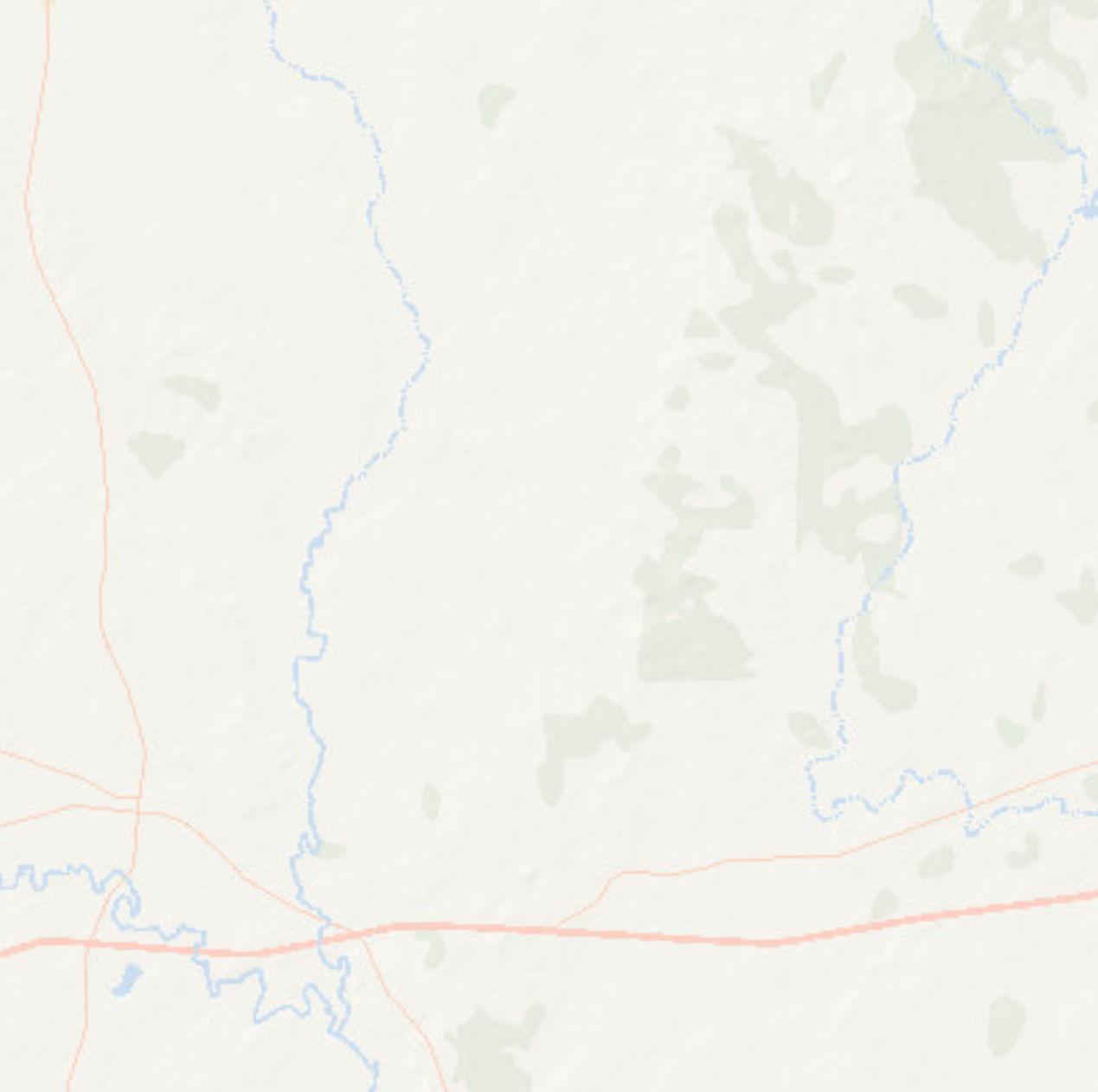
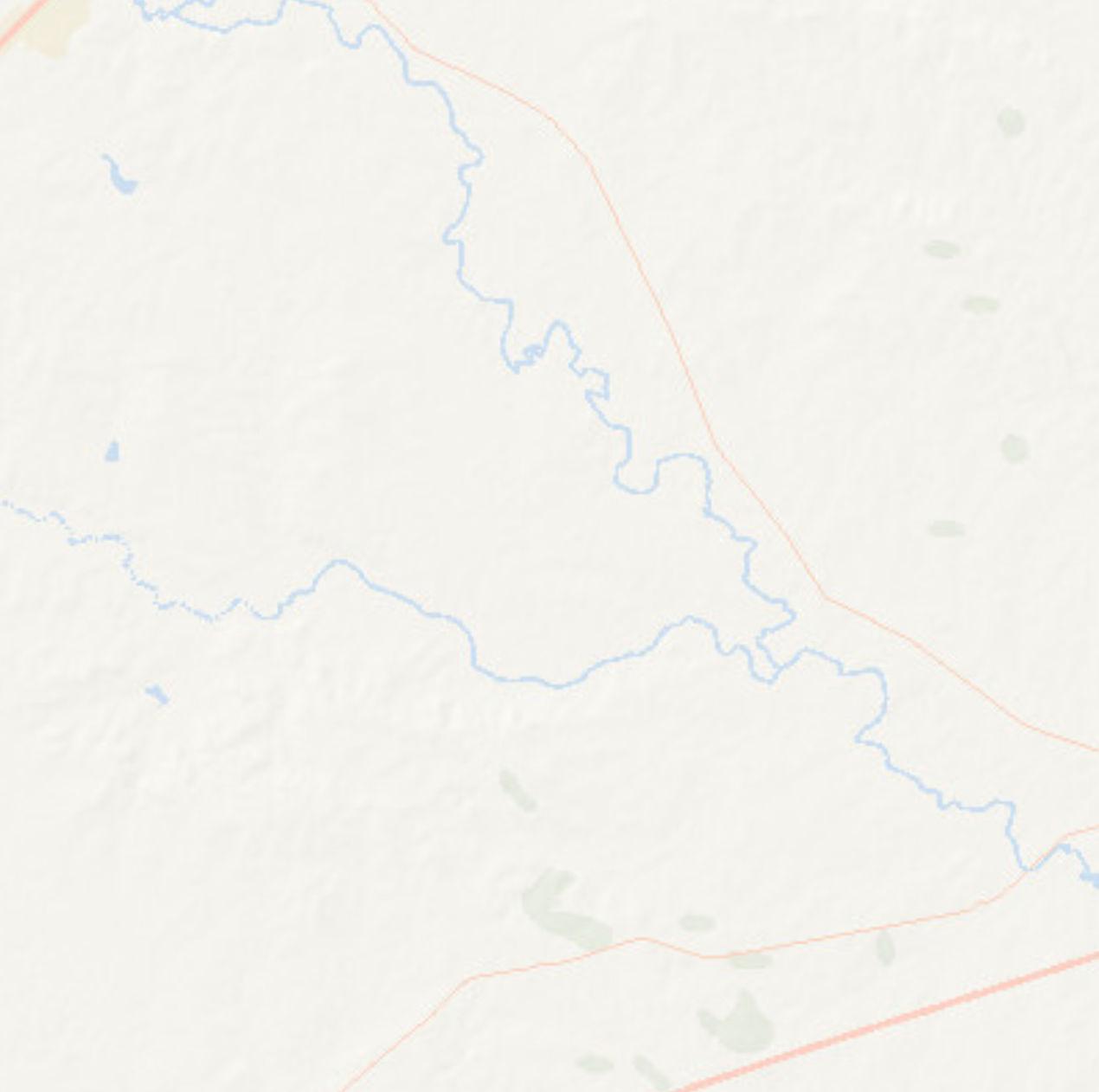


L o c k h a r t K y l e S a n M a r c o s Luling Uhland Staples Buda Mountain City Martindale Niederwald Mustang Ridge Creedmoor CALDWELLGONZALES GUADALUPE HAYS CALDWELL HAYS CALDWELLBASTROP TRAVISCALDWELL To wn Bran ch Lower B l a n c o R i v e r LowerSan Marcos River Pl um Creek Upper Blanco River ydnaS kroF Geronimo Creek Lower San Marcos River Lower San Marcos River Sandy Fork P lumCreek Pl um Creek 1814 1814 1810A 1809 1809 1808 1810 1 8 1 0 G3081 1808 1808 1803G 1810 183 183 90 183 183 90 80 45 45 142 142 80 80 80 304 304 80 21 21 21 21 123 123 130 130 130 130 130 35 10 10 10 10 90 35 35 12640 12647 17406
Stream Gage
Quality Monitoring (GBRA)
Outfall (TCEQ) Major River/Stream Stream Major Roads State Highway (SH) US Highway (US) Interstate Highway (IH) Watershed Boundary County Plum Creek Watershed Summary ¯ 0 2.5 5 1.25 Miles DISCLAIMER: The data contained in this map is not survey grade and is provided for informational and reference purposes only. The Guadalupe-Blanco River Authority makes no claim or guarantee for the accuracy or validity of the information presented herein.
PLUM CREEK 2023 BASIN SUMMARY REPORT 64
USGS
Water
Wastewater
Guadalupe River Basin
Segments
Segment 1810 - Plum Creek
Segment 1810A - Town Branch
Segment Summaries
Plum Creek is a 52-mile-long tributary of the San Marcos River located in Travis, Hays, and Caldwell counties. Plum Creek has a 389-square-mile drainage area that encompasses several cities including Lockhart, Luling, Kyle, and Buda. The watershed spans several ecoregions including the Edwards Plateau, Blackland Prairie, and Post Oak Savannah, and sits over the Carrizo-Wilcox Aquifer, the Leona Aquifer, and Edwards Balcones Fault Zone. Soil types in this watershed range from dark waxy soils to sandy or grey loam. Plum Creek is prone to erosion and tends to have steep banks and a deep-set stream channel, as shown in Photo 9. This watershed has been historically dominated by rural land uses. However, like many watersheds in the Interstate 35 corridor, it is experiencing rapid urbanization and population increase.
Historically an intermittent stream, Plum Creek is fed at its headwaters by springs issuing from the Leona Aquifer, as well as several other springs and tributaries throughout the watershed. As the population has grown in the watershed, increasing wastewater discharge has transitioned Plum Creek into a wastewater dominated perennial stream. In the 1960s and 1970s, twentyeight flood control structures were constructed on several of the tributaries of Plum Creek. These structures capture and hold flood waters during normal and high flow events, and allow for regulated discharge. Contact recreation, including fishing and kayaking are common in the watershed, and the creek is also used by agricultural producers to provide water for crops and livestock. Plum Creek is home to many native species, several of which were collected during an aquatic life monitoring event conducted in 2021 (Photo 10), including five native mussel species. Two of those, the Guadalupe Orb (Cyclonaias necki) and Guadalupe Fatmucket (Lampsilis bergmanni), are proposed Endangered Species Act candidates.
Plum Creek was first added to the 303(d) List of Impaired Water Bodies for bacteria in 2004. In 2006, the TSSWCB, GBRA, and Texas A&M AgriLife

 Photo 9: Plum Creek near CR135 in Luling
Photo 9: Plum Creek near CR135 in Luling
65 WATERSHED SUMMARIES
Photo 10: Native mussels on Plum Creek
Extension began developing a WPP for Plum Creek. The WPP became the first plan in the state of Texas to be accepted by EPA and implementation began in 2008. In 2010, TCEQ moved Plum Creek from category 5a to category 4b, removing it from the 303(d) list. While category 5a requires the development of total maximum daily loads (TMDLs), category 4b allows the WPP to attempt to address the water quality concerns through best management practices (BMPs) and education. BMPs implemented under the WPP include feral hog management, proper maintenance of septic systems, and non-point source nutrient management.
There are three stations in Plum Creek monitored monthly under the CRP. Extensive additional monitoring is conducted under the Plum Creek WPP, including seven wastewater treatment facilities, four routine sites, thirty-four weather targeted sites, and three springs. While not currently monitored by CRP, there are concerns on the Town Branch (segment 1810A) that is monitored under the WPP monitoring program that would be beneficial to discuss. More information on the WPP and water quality data collected under that program can be found at www.plumcreekwatershed.org.
M - Meets water quality criteria
C - Concern for water quality criteria
I - Impaired for water quality criteria
No significant trends were identified in the middle or lower reaches of this segment. In the upper reach of the segment, analyses show a decreasing trend in E. coli over time (Figure 43). This improvement may be related to implementation of BMPs through the WPP. Other factors contributing to the decrease might be more efficient wastewater treatment, or an increase in flow over time.
Station ID Dissolved Oxygen Biologicals Bacteria Temperature Nutrients Chlorophyll a 12640 M C I M C M 12647 M C I M C M 17406 M C I M C M
Table 18: Summary of the 2022 Texas Integrated Report / Segment 1810
2023 BASIN SUMMARY REPORT 66
Analysis also showed a decreasing trend in nitrate-nitrogen at station 17604 (Figure 44). This change may indicate improvements in wastewater treatment as more ammonia is converted to nitrate-nitrogen through the treatment process.

 Figure 43: E.coli trend at Station 17406
Figure 43: E.coli trend at Station 17406
67 WATERSHED SUMMARIES
Figure 44: Nitrate-Nitrogen trend at Station 17406
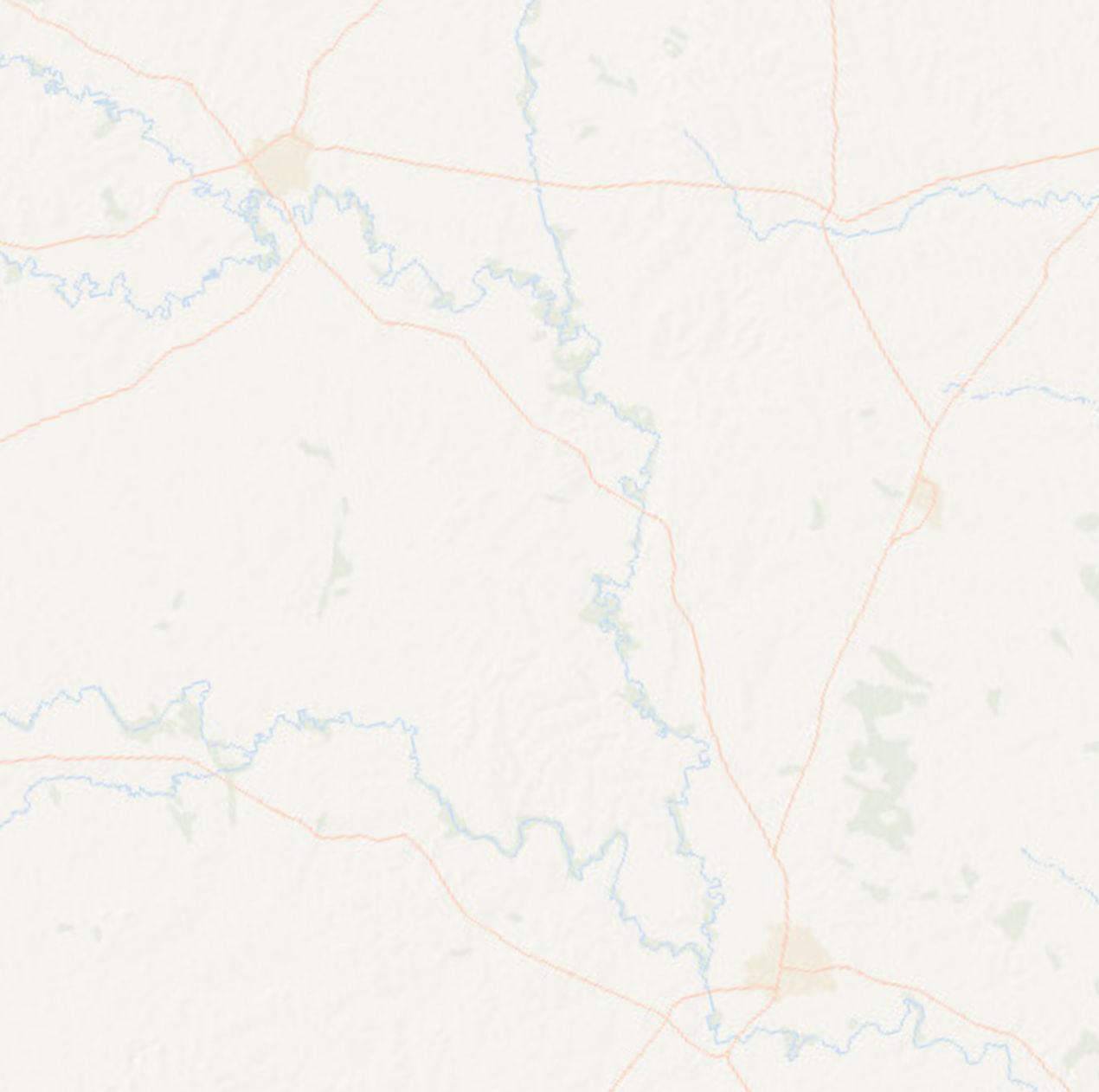
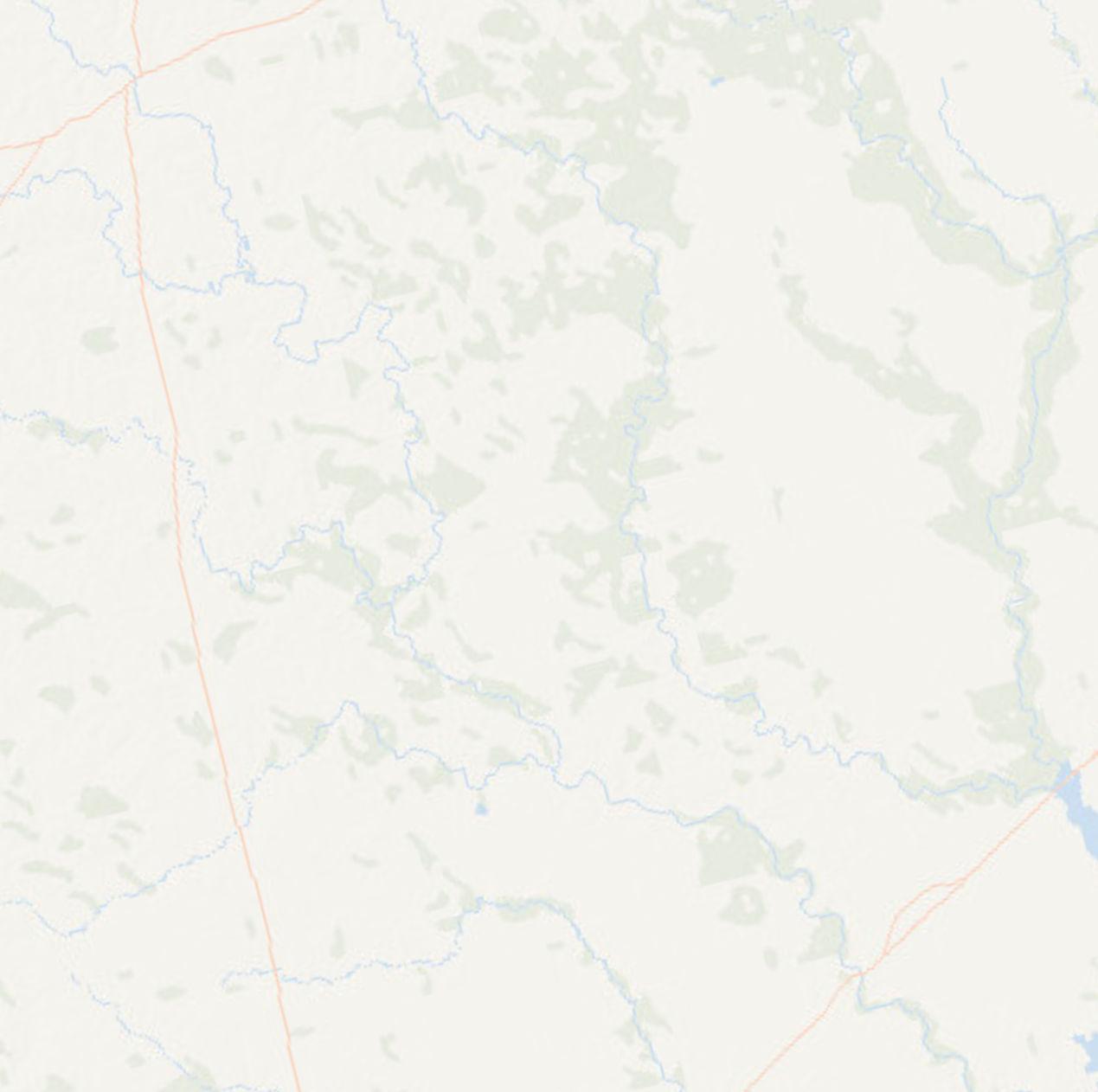
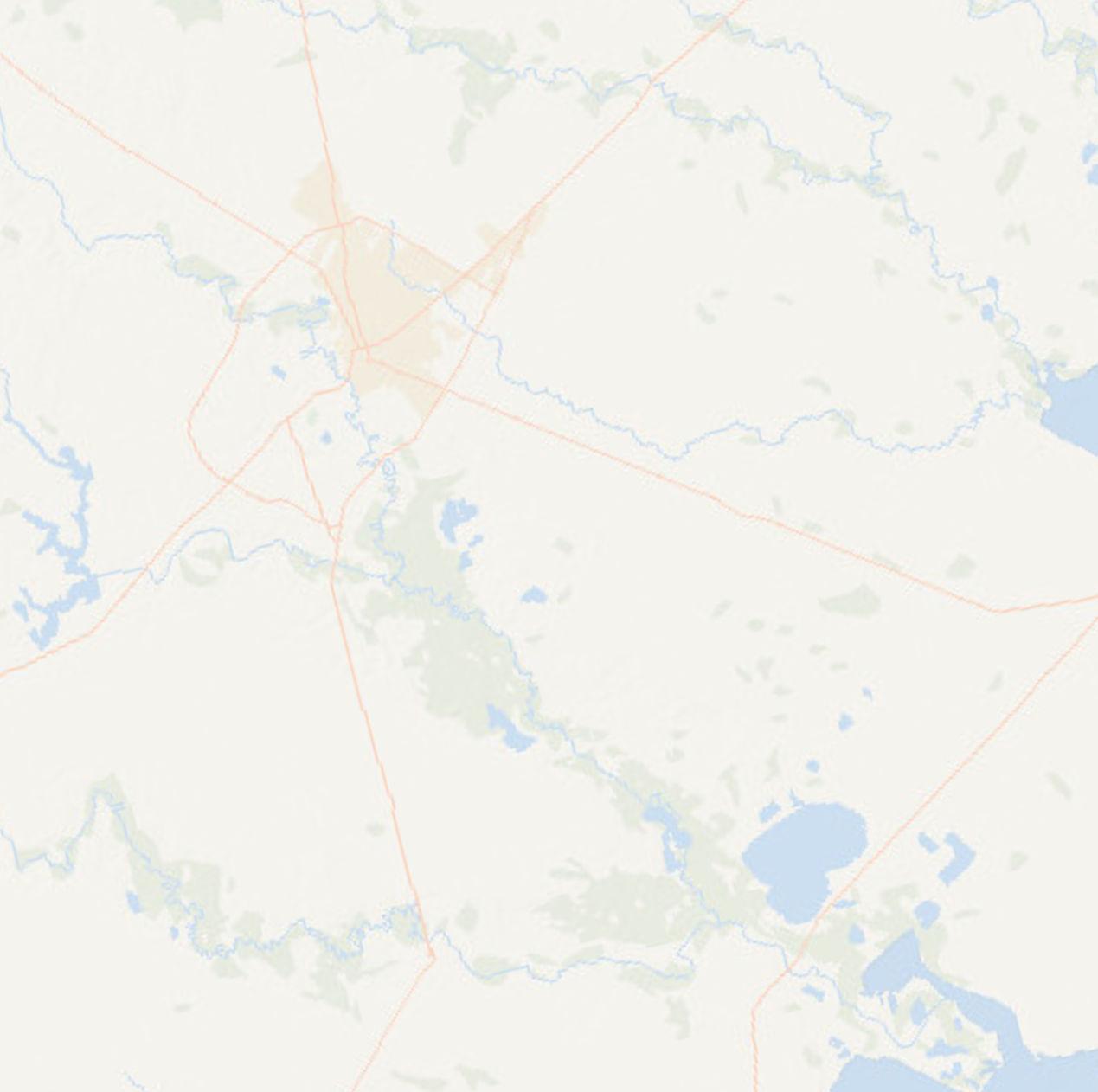




LOWER GUADALUPE RIVER V i c t o r i a Gonzales Nordheim Yorktown Smiley Cuero VCALHOUN ICTORIA DEGOLIAD WITT DEVICTORIA WITT VICTORIA KARNESDEWITT KARNES GONZALES DEWITTLAVACA DE GONZALESWITT GONZALESLAVACA LAVACA GONZALES DE WITT REFUGIO CALHOUN JACKSON LAVACAJACKSON COLORADO COLORADOWHARTON JACKSONWHARTON 183 77 77 77 87 59 87 77 59 183 183 59 77 87 185 239 239 35 35 97 97 185 185 185 95 95 239 239 239 111 111 111 119 119 119 119 72 72 72 72 ALT 90 183 ALT 90 ALT 90 ALT 90 87 87 ALT 77 ALT 77 ALT 90 72 183 183 87 87 77 87 87 BUS 77 BUS 77 BUS 59 59 59 59 59 239 59 111 Irish Creek Guadalupe River G u a d a l u peRiver Guadalupe River G uad alupeRiver 1802 1803 1803 1803 1803 1 803 1803 1803 GuadalupeRiver 1803 Irish C r e e k Kuy Creek GuadalupeRiver Tidal 1801 20470 12592 12590 12578 12577 USGS Stream Gage Water Quality Monitoring (GBRA) Water Quality Monitoring (TCEQ) Wastewater Outfall (TCEQ) Major River/Stream Stream Major Roads State Highway (SH) US Highway (US) Interstate Highway (IH) Watershed Boundary County Lower Guadalupe River Watershed Summary ¯ 0 5 10 2.5 Miles DISCLAIMER: The data contained in this map is not survey grade and is provided for informational and reference purposes only. The Guadalupe-Blanco River Authority makes no claim or guarantee for the accuracy or validity of the information presented herein. Guadalupe River Basin GBRA Saltwater Barrier 2023 BASIN SUMMARY REPORT 68
Segments
Segment 1801 - Guadalupe River Tidal

Segment 1802 - Lower Guadalupe River Below San Antonio River
Segment 1803 - Lower Guadalupe River Below San Marcos River
Segment Summaries
Guadalupe River Tidal (1801)
Guadalupe River Tidal is the 10-mile-long stretch of the Guadalupe River from the GBRA Salt Water Barrier to the confluence of Guadalupe Bay. As this segments name suggests, it is a tidally influenced zone. This segment is prone to frequent log jams which typically occur around bridges, railroad crossings, and other obstructions in the river, restricting flow, altering the river channel, and creating new ecosystems within the segment. The flood plain can often extend several miles beyond the stream banks in this segment. The GBRA Salt Water Barrier is used by GBRA to maintain headwater elevation, divert river flow into GBRA’s system of surface water canals, and to prevent brackish waters from traveling upstream during times of low river flows. Originally constructed in 1964, the Saltwater Barrier consisted of two 10-ft by 50-ft water filled rubber bladder spillway gates that were anchored to the concrete foundation. In June 2022, the rubber bladders were damaged and the decision was made to replace the bladders with steel gates. Installation of the new gates is expected to be complete in early 2023.
Guadalupe River Tidal is monitored quarterly by TCEQ at one station (12577), located at the state highway 35 tidal bridge northeast of Tivoli. Bacteria (enterococcus) in this segment has been reported above the screening criteria since 2014, however until recently there were not enough data points to make a confident assessment for impairment. As a result, segment 1801 has had a concern for bacteria since the 2014 Texas Integrated Report; that concern was moved to an impairment on the 2022 Texas Integrated Report.
Station ID Dissolved Oxygen Biologicals Bacteria Temperature Nutrients Chlorophyll a 12577 M M I M C M M - Meets water quality criteria C - Concern for water quality criteria I - Impaired for water quality criteria
Aerial View of GBRA Salt Water Barrier
69 WATERSHED SUMMARIES
Table 19: Summary of the 2022 Texas Integrated Report / Segment 1801
Lower Guadalupe River Below San Antonio River (1802)
Lower Guadalupe River Below San Antonio River is a 0.4-mile-long section of the Guadalupe River that stretches from the GBRA Salt Water Barrier to the confluence of the San Antonio River. This segment is a typical slow-moving coastal river and is the most downstream segment of the Guadalupe River that is not tidally influenced. This segment lies in the Western Gulf Coast Ecoregion and is characterized by floodplains and low terraces of alluvial sediments. Lowland forests of elm, water oak, and ash trees are common, as well as grazed pastureland and cropland. GBRA monitors this segment monthly at station 12578, located upstream of the Saltwater Barrier.
M - Meets water quality criteria
C - Concern for water quality criteria
Trend analyses performed on data from this segment show an increasing trend for chloride (Figure 45), and grab samples collected in 2021 exceeded the screening criteria for chloride for the first time during the reported period. This segment receives considerable inflow from the San Antonio River, which could be a contributing factor to this increase. Another potential contributor to the increase in chlorides could be saltwater intrusion.

Station ID Dissolved Oxygen Biologicals Bacteria Temperature Nutrients Chlorophyll a 12578 M M M M C M
Table 20: Summary of the 2022 Texas Integrated Report / Segment 1802
2023 BASIN SUMMARY REPORT 70
Figure 45: Chloride trend at Station 12578
Lower Guadalupe River Below San Marcos River (1803)
Lower Guadalupe River Below San Marcos River is a 161.5-mile-long stretch of river that begins west of Gonzales at the confluence with the San Marcos River and ends at the confluence with the San Antonio River. The segment flows through Dewitt, Victoria, and Calhoun counties and has numerous tributaries including Peach Creek and Sandies Creek. This portion of the Guadalupe River is characterized by a large river channel and slow-moving waters with minimal elevation changes, and flows through the Southern Post Oak Ecoregion, Savannah Ecoregion, and southern Blackland Prairie ecoregions. Soils in this watershed range from sandy, to clay, to sandy-clay.
Two proposed endangered species of mussels have been found in this segment, the false spike (Fusconaia mitchelli) and Guadalupe orb (Cyclonaias necki). The Guadalupe orb (Photo 10) is endemic to the Guadalupe River Basin, meaning that it is only found in this river system. Currently GBRA monitors three stations in segment 1803; all three are located in the upper half of the segment. GBRA previously monitored an additional station (16579), in the lower portion of this segment. Monitoring was discontinued at that site in 2006 when it was discovered that it was in the mixing zone of an industrial wastewater discharge. GBRA was unable to find a suitable location with adequate access in that area to continue monitoring. The lower portion of 1803 has a concern for nitratenitrogen, however it is believed that this concern is not representative of ambient conditions and is likely a result of the samples collected within the mixing zone. The middle and upper portions of 1803 have no concerns or impairments and exhibit a high level of water quality.

Station ID Dissolved Oxygen Biologicals Bacteria Temperature Nutrients Chlorophyll a 12590 M M M M M M 12592 M M M M M M 20470 M M M M M M M - Meets water quality criteria
Photo 10:Guadalupe Orb
71 WATERSHED SUMMARIES
Table 21: Summary of the 2022 Texas Integrated Report / Segment 1803
Though still below the screening level, analyses showed increasing trends for nitrate-nitrogen at all three stations in this segment. Data from station 20470 is shown here (Figure 46). Increased non-point source pollution from agriculture in the surrounding watershed could be a contributing factor.
 Figure 46: Nitrate trend at Station 20470
Figure 46: Nitrate trend at Station 20470
2023 BASIN SUMMARY REPORT 72






SANDIES CREEK Nixon Gonzales Smiley KARNESGONZALES DEWITT GONZALES WILSONGONZALES GUADALUPEGONZALES GONZALESDEWITT LittleElm Crk Salty Creek SanMarcosRiver Guadalupe River Pea ch C r e e k Guadalupe River Below Comal River Elm Creek Elm Creek Guadalupe River Below ComalRiver Guadalupe River aS n d i es Creek Sandies Creek SandiesCreek G u adal u p e River 1804 1803E 1803 1803D 1804 1808 180 3 C 1803A 1804 1803B 1 803B 1 8 0 3 1803A 1803B 183 87 97 97 97 119 119 119 72 72 80 80 80 80 80 183 ALT 90 ALT 90 87 87 87 183 13657 17894 USGS Stream Gage Water Quality Monitoring (GBRA) Wastewater Outfall (TCEQ) Major River/Stream Stream Major Roads State Highway (SH) US Highway (US) Interstate Highway (IH) Watershed Boundary County Sandies Creek Watershed Summary ¯ 0 2.5 5 1.25 Miles DISCLAIMER: The data contained in this map is not survey grade and is provided for informational and reference purposes only. The Guadalupe-Blanco River Authority makes no claim or guarantee for the accuracy or validity of the information presented herein. Guadalupe River Basin 73 WATERSHED SUMMARIES
Segments
Segment 1803A - Elm Creek
Segment 1803B - Sandies Creek
Segment Summary
Elm Creek (1803A)
Elm Creek is a 31-mile-long segment that begins west of Nixon in Wilson County and flows through Karnes and Gonzales counties before joining with Sandies Creek east of Smiley. Elm Creek has more than 15 different tributaries, and its watershed covers 135-square-miles. Lying completely within the Southern Post Oak Savannah Ecoregion, this watershed is characterized by sand and sandy loam soils that transition to dense clay pan soils. Land use in the watershed is primarily scrubland, with some improved hay pasture and post oak forest scattered throughout.
Elm Creek is monitored quarterly by GBRA at station 17894, but data at this station were not analyzed for trends because the period of record for this site is too short to produce trends. Station 17894 was added in 2020 to confirm the impairment for dissolved oxygen. Elm Creek has been listed on the 303(d) List of Impaired Water Bodies since 1999 for depressed dissolved oxygen levels and for bacteria since 2002.
Station ID Dissolved Oxygen Biologicals Bacteria Temperature Nutrients Chlorophyll a 17894 I M I M M M M - Meets water quality criteria
- Impaired for water quality criteria
I
2023 BASIN SUMMARY REPORT 74
Table 22: Summary of the 2022 Texas Integrated Report / Segment 1803A
Sandies Creek is a 79-mile-long tributary of the Lower Guadalupe River. Originating in Guadalupe County near Nixon, the creek meanders through Gonzales and DeWitt counties before joining up with the main stem of the Guadalupe River west of the town of Cuero. This watershed has a 711-squaremile drainage area and lies above the Carrizo-Wilcox and Gulf Coast aquifers. As the name would suggest, the soils in the Sandy Creek watershed are comprised mainly of sandy substrate. This creek has several tributaries including Elm Creek (1803A), Salty Creek (1803D), Little Elm Creek, Clear Fork Creek, Five Mile Creek, and fourteen or more other unnamed tributaries. The watershed lies mostly within the Southern Post Oak Savannah Ecoregion, with the lower end of the watershed in the Blackland Prairie which has more clay-like substrate. This watershed is largely rural; livestock and farming dominate the land uses with hay production being one of the primary types of agriculture.

The Eagle Ford Shale formation lies under this watershed in Gonzales and DeWitt counties. Since 2008, companies have been drilling into the Eagle
Ford to extract oil and gas, mainly through the process of hydraulic fracturing. The extensive use of this process in the region has led to concerns over its potential impacts on groundwater and surface water. Hydraulic fracturing requires large amounts of water, and the by-products of the process have the potential to contaminate nearby water sources if not properly handled. Stakeholders, including landowners and agricultural producers, main concern is the future availability of water in the already water-scarce area.
GBRA monitors Sandies Creek monthly at one station (13657) which is located at the Cheapside Road bridge crossing in northeast DeWitt County. Sandies Creek has been listed on the 303(d) List of Impaired Water Bodies since 1999 for depressed dissolved oxygen levels and for bacteria since 2002; these impairments are still listed for segment 1803B as of the 2022 Texas Integrated Report. In 2020 and 2021, GBRA conducted additional monitoring at site 15998, located at FM 1116 east of Smiley. Data from this site was used to confirm the DO and bacteria impairments. This segment also previously had impairments for fish community and macrobenthic community and a concern for habitat; however, those were not included in the 2022 Texas Integrated Report. A use attainability analysis was performed in the watershed, and the designated aquatic life use was subsequently changed from high to intermediate in the 2018 Texas Surface Water Quality Standards.
Sandies Creek (1803B)
Sandies Creek
75 WATERSHED SUMMARIES
M - Meets water quality criteria
I - Impaired for water quality criteria
Table 23: Summary of the 2022 Texas Integrated Report / Segment 1803B
Data analyzed from station 13657 showed an increasing trend in sulfate over time (Figure 47). Increased runoff from oil field activity in the area could be a cause of this increase.

Station ID Dissolved Oxygen Biologicals Bacteria Temperature Nutrients Chlorophyll a 13657 I M I M M M
2023 BASIN SUMMARY REPORT 76
Figure 47: Sulfate trend at Station 13657







Gonzales Waelder Flatonia GONZALESLAVACA LAVACA FAYETTE CALDWELLGONZALES GONZALESFAYETTE BASTROPFAYETTE CALDWELLBASTROP San MarcosRi ver Pl um Creek Peach C r e e k Denton Creek Sandy Fork PeachCreek SanMarcosRiver Guadalupe River Pea ch C r e e k Peach Creek SandyFork 1804 1808 1803 1810 1 8 0 3 C 1 8 1 0 1803F 1803G 1803C 1808 180 3 C 1803G 183 90 90 97 97 97 97 95 95 95 95 95 304 304 304 304 10 10 10 10 90 ALT 90 183 183 ALT 90 ALT 90 ALT 90 12640 12647 14937
Stream Gage Water Quality Monitoring (GBRA)
Outfall (TCEQ)
River/Stream Stream Major Roads State Highway (SH) US Highway (US) Interstate Highway (IH) Watershed Boundary County Peach Creek Watershed Summary ¯ 0 2.5 5 1.25 Miles DISCLAIMER: The data contained in this map is not survey grade and is provided for informational and reference purposes only. The Guadalupe-Blanco River Authority makes no claim or guarantee for the accuracy or validity of the information presented herein. Guadalupe River Basin PEACH CREEK 77 WATERSHED SUMMARIES
USGS
Wastewater
Major
Segments
Segment 1803C - Peach Creek
Segment Summary
Peach Creek is a tributary of the Guadalupe River that flows east and then south through Bastrop and Fayette counties before reaching its confluence with the Guadalupe River in eastern Gonzales County. Peach Creek is a 64-mile-long segment that is fed by numerous named and unnamed tributaries throughout the reach, and has a 480-square-mile drainage area. This watershed is rural and consists mainly of undeveloped agricultural and ranch land. Hay pastures are a common sight in this watershed. The watershed falls entirely within the Post Oak Savannah ecoregion and lies over the Carrizo-Wilcox Aquifer. Soils in the watershed mainly consist of sandy loam, and forests of Post Oak, Blackjack Oak, and other hardwoods are common.
Peach Creek was first included on the 303(d) List of Impaired Water Bodies in 2002 for bacteria. In 2006 an additional impairment was added for depressed levels of dissolved oxygen. A TMDL was adopted for Peach Creek in 2008, recommending a 47 to 100 percent reduction in loading of bacterial sources. To date, no implementation of BMPs have been initiated. The TMDL determined that bacteria loading was most likely due to non-point source pollution sources including failing septic systems, livestock, and wildlife. BMPs to reduce agricultural runoff and programs to encourage and facilitate proper maintenance of septic systems could help to reduce bacteria loads in the creek. GBRA collects monthly monitoring data at one station (14937) within this segment, located at the CR 353 bridge crossing in the lower reach of the segment.
M - Meets water quality criteria
C - Concern for water quality criteria
I -
criteria
Recently GBRA conducted an aquatic life monitoring event on segment 1803c near the CR 353 bridge crossing. Fish and macroinvertebrates were sampled, and habitat assessments were performed twice in 2020. Segment 1803c has a high Aquatic Life Use designation; however, this monitoring confirmed the concern for macroinvertebrates.

Station ID Dissolved Oxygen Biologicals Bacteria Temperature Nutrients Chlorophyll a 14937 I C I M C C
Impaired for water quality
Table 24: Summary of the 2022 Texas Integrated Report / Segment 1803C
Electrofishing in Peach Creek
2023 BASIN SUMMARY REPORT 78
Data from station 14937 show an increasing trend in chlorides (Figure 48) and TDS (Figure 49). This could be due to decreased flows over time, or possibly a result of upstream discharges from wastewater or industrial effluent.

 Figure 48: Chloride trend at Station 14937
Figure 48: Chloride trend at Station 14937
Segment Mean Macroinvertebrate Score Mean Fish Score Mean Habitat Score 1803C Intermediate High High
Figure 49: Total dissolved solids trend at Station 14937
79 WATERSHED SUMMARIES
Table 25: Summary of the 2020 Biological Monitoring / Segment 1803C







COLETO CREEK ColetoCreek C o l e t o Creek Perdido Creek San Antonio R i v e r uG adal u p e River aS n d i es Creek 1807 1807 Guadalupe River Th o m a s Creek SaltCreek Twelve Mile Creek Coleto Creek Coleto Creek Reservoir Nordheim Yorktown Cuero V i c t o r i a DEGOLIAD WITT KARNESGONZALES DEWITT GONZALES DEVICTORIA WITT GOLIAD VICTORIA 183 87 183 59 87 239 239 239 239 119 119 119 72 72 72 72 87 ALT 77 72 183 183 77 77 59 87 87 59 59 20827 USGS Stream Gage Water Quality Monitoring (GBRA) Wastewater Outfall (TCEQ) Major River/Stream Stream Major Roads State Highway (SH) US Highway (US) Interstate Highway (IH) Watershed Boundary County Coleto Creek Watershed Summary ¯ 0 2.5 5 1.25 Miles DISCLAIMER: The data contained in this map is not survey grade and is provided for informational and reference purposes only. The Guadalupe-Blanco River Authority makes no claim or guarantee for the accuracy or validity of the information presented herein. Guadalupe River Basin 2023 BASIN SUMMARY REPORT 80
Segments

Segment 1807 - Coleto Creek
Segment Summary
Coleto Creek is a 27-mile-long segment with a 558-square-mile watershed. This segment begins in Dewitt County and flows through Goliad and Victoria counties before joining the main stem of the Guadalupe River. The large watershed around this segment makes this normally slowmoving creek prone to flash flooding during heavy rain events. Soil types in this segment are mostly sandy to sandy loam, with some areas of clay loam. The watershed is mostly rural with limited development, and it supports a wide range of wildlife including turkey, bobcats, whitetail deer, and red foxes. Segment 1807 also includes Coleto Creek Reservoir, a 3,100-acre impoundment maintained by GBRA. Coleto Creek Reservoir and the surrounding park are popular sites for camping and fishing. The reservoir is an excellent site to fish for largemouth bass and crappie, with frequent reports of five to eight-pound largemouth bass being caught. Kayaking and swimming are common at Coleto; however, caution should be exercised as there is a population of alligators in the reservoir. The reservoir is also popular with bird watchers as it provides habitat to over 100 bird species including bald eagle, roseate spoonbill, and American kestrel.
GBRA monitors segment 1807 monthly at one site, located at the center of the dam at Coleto Creek Reservoir.
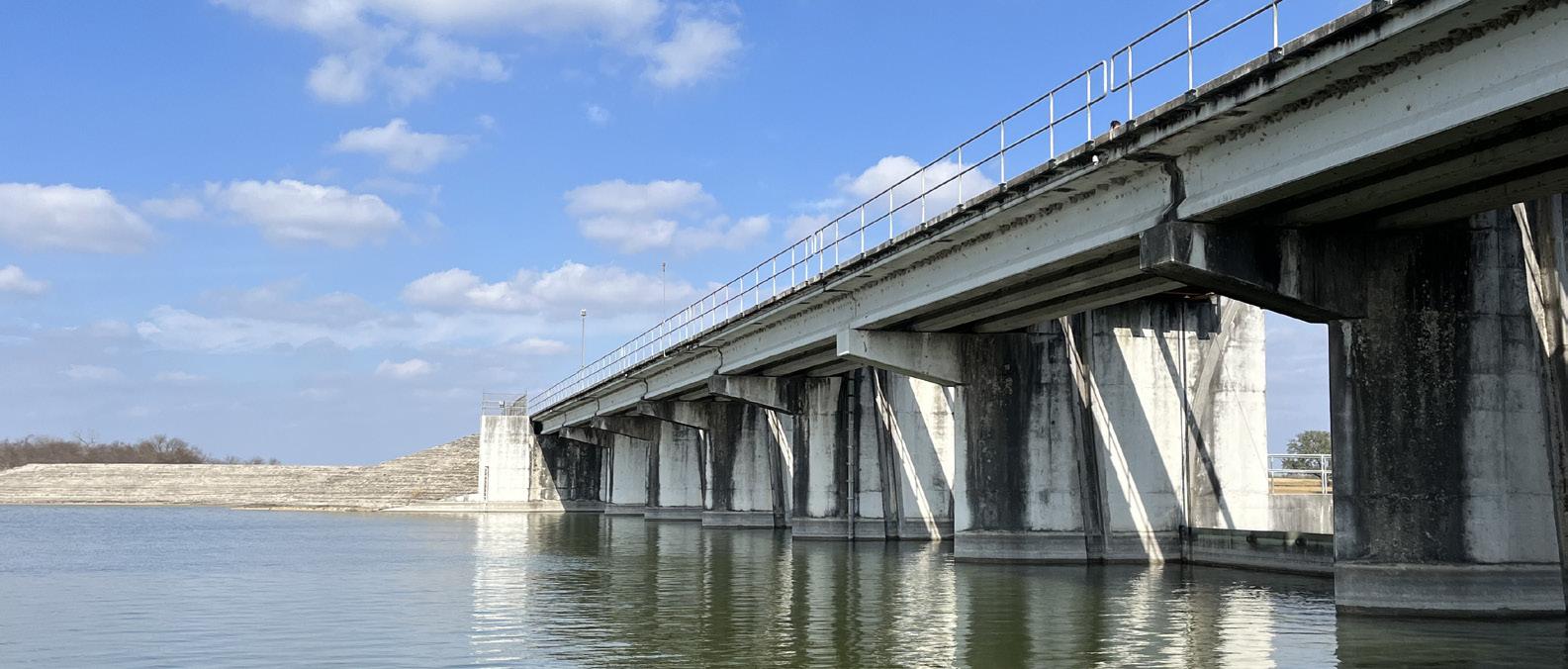
Station ID Dissolved Oxygen Biologicals Bacteria Temperature Nutrients Chlorophyll a 20827 M M M M M C M - Meets water quality criteria C - Concern for water quality criteria
Table 26: Summary of the 2022 Texas Integrated Report / Segment 1807
Coleto Creek Reservoir
81 WATERSHED SUMMARIES
Alligator at Coleto Creek Park
Several statistically significant trends were identified:
Decreasing trends were seen for chloride (Figure 50) and sulfate (Figure 51) over time in this segment. These trends are significantly correlated to the reservoir stage; as stage increases, chloride and sulfate decrease. A cyclical trend in stage height is seen in the reservoir with the lowest stage typically observed in the summer and highest stage seen in the winter.


An increasing trend for chlorophyll a (Figure 52) was identified at this station. The trend could be linked to increased nutrient loading from the surrounding rural watershed.
 Figure 50: Chloride trend at Station 20872
Figure 51: Sulfate trend at Station 20872
Figure 50: Chloride trend at Station 20872
Figure 51: Sulfate trend at Station 20872
2023 BASIN SUMMARY REPORT 82
Figure 52: Chlorophyll a trend at Station 20872
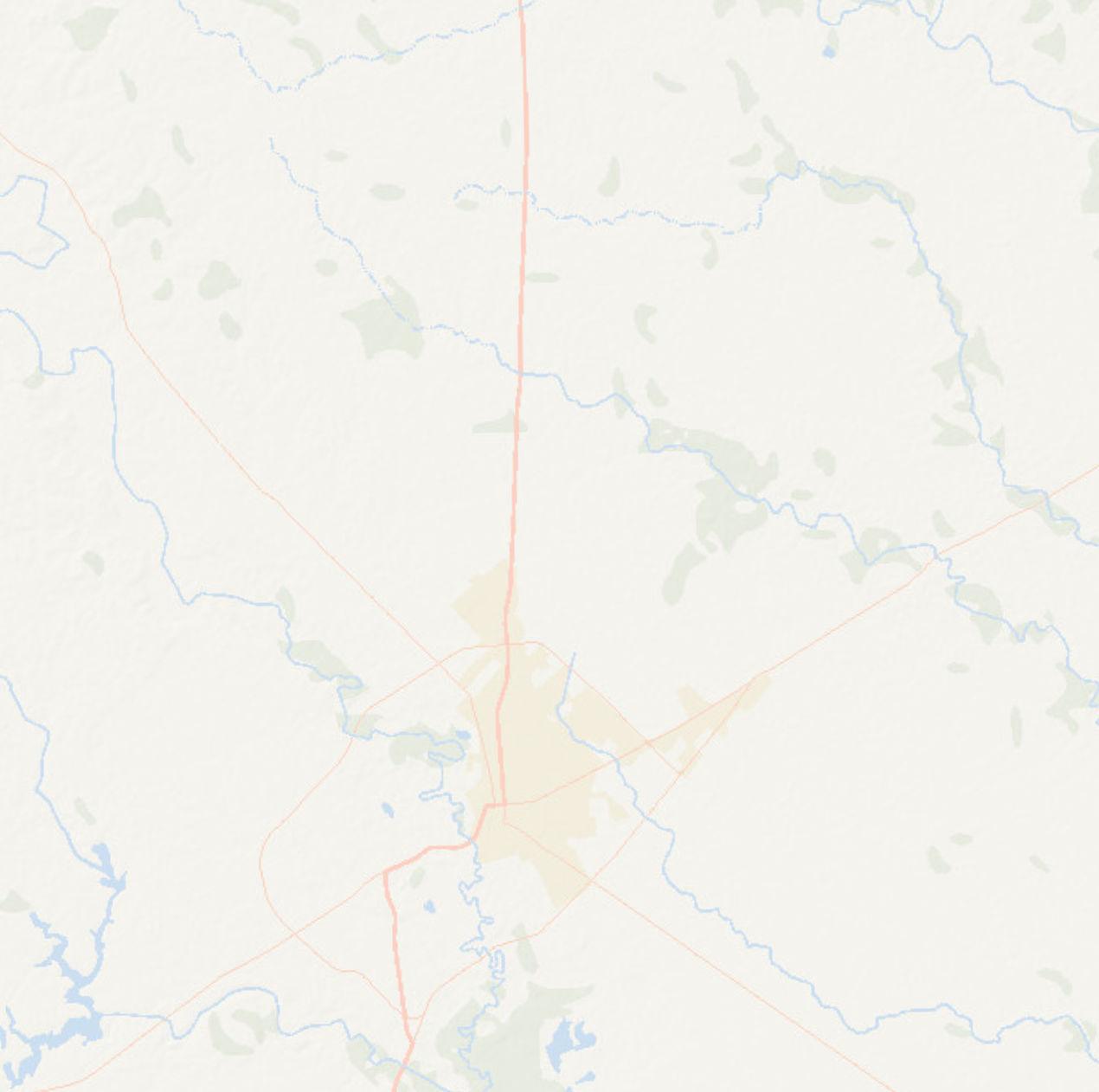
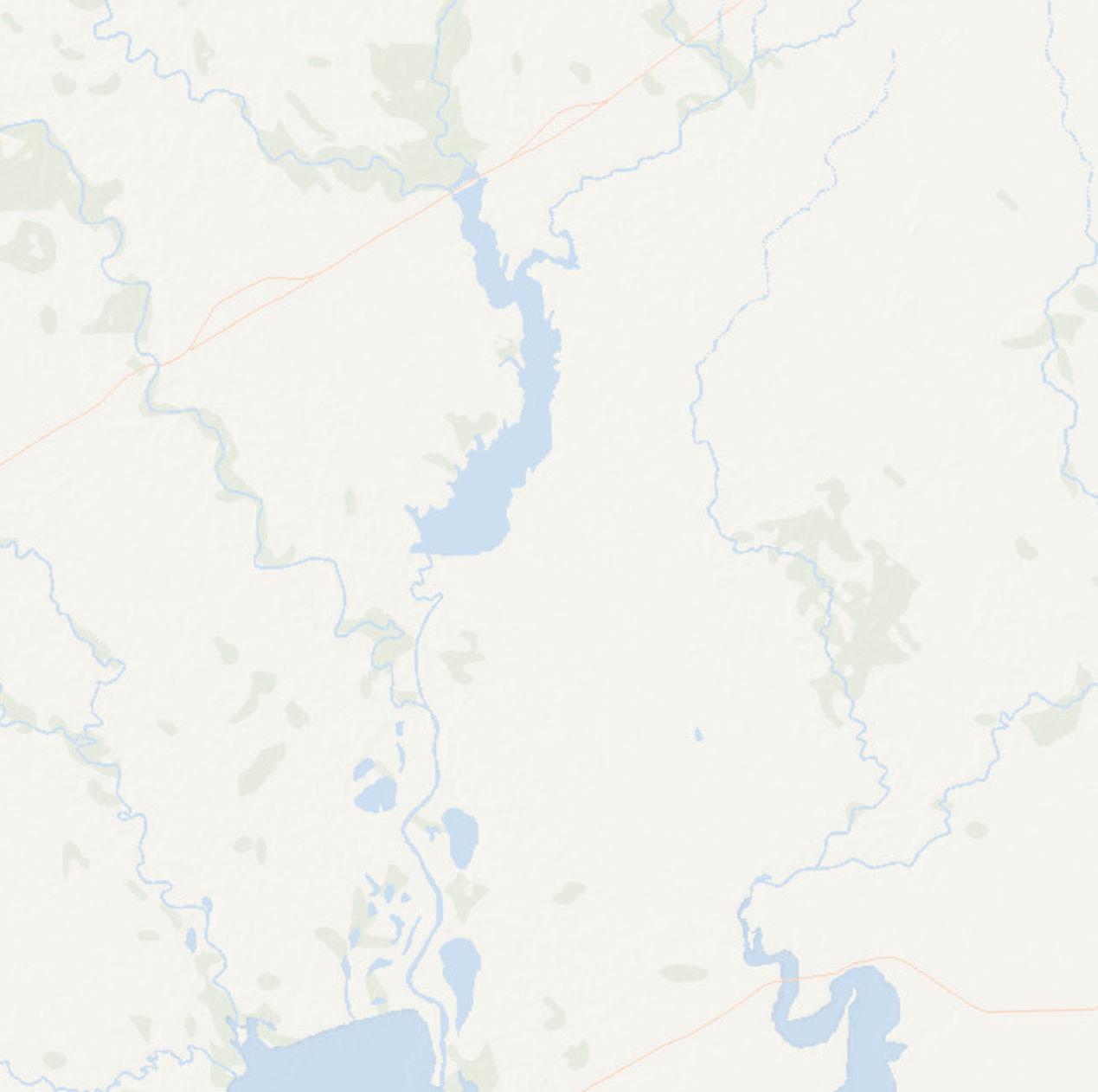





LAVACA-GUADALUPE COASTAL BASIN V i c t o r i a Port Lavaca Port O'Connor Seadrift VCALHOUN ICTORIA DEVICTORIA WITT VICTORIA REFUGIOCALHOUN JACKSON G r eenLa ke Lavaca Bay Matagorda Bay San Antonio Bay Mission Lake PowderhornLake 1701 VictoriaBarge C a n al 1701 1701 VictoriaBargeCanal GarcitasCreek Arenosa Creek PlacedoCreek 77 77 77 87 77 59 185 35 172 316 316 239 238 238 238 35 35 35 185 185 185 185 185 185 87 87 77 87 87 BUS 77 BUS 77 BUS 59 59 59 59 59 77 239 239 35 239 59 111 12536
USGS Stream Gage
Water Quality Monitoring (TCEQ)
Wastewater Outfall (TCEQ)
Roads State Highway (SH) US Highway (US)
Highway (IH)
Boundary County
Major River/Stream Stream Major
Interstate
Watershed
Guadalupe
Lavaca -
Summary ¯ 0 5 10 2.5 Miles DISCLAIMER: The data contained in this map is not survey grade and is provided for informational and reference purposes only. The Guadalupe-Blanco River Authority makes no claim or guarantee for the accuracy or validity of the information presented herein.
83 WATERSHED SUMMARIES
Coastal Watershed
Guadalupe River Basin
Segments
Segment 1701 - Victoria Barge Canal

Segment Summary
Victoria Barge Canal (1701)
The Victoria Barge Canal is a 35-mile-long, man-made stream segment that was completed in 1968 and is operated by the US Army Corps of Engineers. The canal was constructed to provide a navigable waterway from the Port of Victoria to the Gulf Intracoastal Waterway, which is located at the confluence with San Antonio Bay in Calhoun County. The waterway provides a more direct route for barge traffic to reach the Port of Victoria while avoiding frequent log jams and course changes in the Lower Guadalupe River. The canal was originally constructed at nine feet deep and 100 feet wide, but was expanded to twelve feet deep and 125 feet wide in 2002. This canal has high shipping traffic and is utilized by several industrial manufacturing plants as well as other industries that transport goods through the Port of Victoria.
Unlike many other tidally influenced segments, the Victoria Barge Canal does not receive direct freshwater influences from any perennial rivers or streams. Most of the water in the canal system comes from the San Antonio Bay system; freshwater inflow to the canal comes from industrial wastewater effluent and stormwater runoff. The Victoria Barge Canal is monitored quarterly by TCEQ at one station (12536), located at the State Highway 35 bridge crossing. This segment has no impairments, but the 2022 Texas Integrated Report lists a concern for chlorophyll-a. A concern for nitrate-nitrogen that was listed on previous Integrated Reports was removed from the 2022 Report.
M - Meets water quality criteria
C - Concern for water quality criteria
Table 27: Summary of the 2022 Texas Integrated Report / Segment 1701
Station ID Dissolved Oxygen Biologicals Bacteria Temperature Nutrients Chlorophyll a 12536 M M M M M C
2023 BASIN SUMMARY REPORT 84
Brown Pelican near Hynes Bay
Data collected at station 14937 shows an increasing trend for Chlorophyll a (Figure 53). Decreased flows are a likely contributor to this trend.
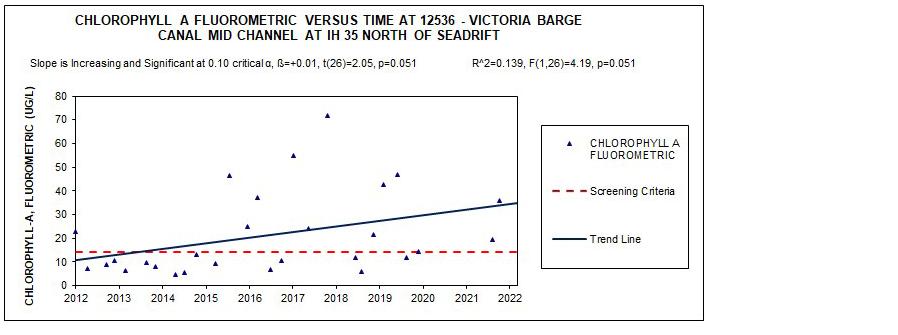 Figure 53: Chlorophyll a trend at Station 12536
Figure 53: Chlorophyll a trend at Station 12536
85 WATERSHED SUMMARIES


























 Photo 4: Monitoring Water Quality Near a Low-Head Dam in the South Fork Guadalupe River at Hunt Crossing
Photo 4: Monitoring Water Quality Near a Low-Head Dam in the South Fork Guadalupe River at Hunt Crossing




 Figure 3: Chloride trend at Station 15111
Figure 4: Sulfate trend at Station 12546
Figure 3: Chloride trend at Station 15111
Figure 4: Sulfate trend at Station 12546











 Figure 10: Dissolved oxygen trend at Station 15113
Figure 11: Log10 E.coli trend at Station 15113
Figure 8: Total dissolved solids trend at Station 12608
Figure 10: Dissolved oxygen trend at Station 15113
Figure 11: Log10 E.coli trend at Station 15113
Figure 8: Total dissolved solids trend at Station 12608





 Canyon Lake
Canyon Lake


 Figure 12: Spring DO at Station 12601
Figure 13: Summer/Fall DO at Station 12601
Figure 12: Spring DO at Station 12601
Figure 13: Summer/Fall DO at Station 12601







 Figure 15: Chloride trend at Station 12656
Figure 15: Chloride trend at Station 12656







 Photo 6: Riffle Beetle
Photo 7: Fountain Darter
Photo 6: Riffle Beetle
Photo 7: Fountain Darter



 Figure 20: E.coli at Station 12570
Figure 20: E.coli at Station 12570









 Figure 23: Dissolved oxygen trend at Station 17134
Figure 23: Dissolved oxygen trend at Station 17134

 Figure 25: Log10 E.coli trend at Station 12596
Figure 25: Log10 E.coli trend at Station 12596














 Figure 28: TSS trends at Station 12665
Figure 28: TSS trends at Station 12665


 Figure 30: Sulfate trend at Station 12668
Figure 31: Chloride trend at Station 12668
Figure 30: Sulfate trend at Station 12668
Figure 31: Chloride trend at Station 12668



 Figure 33: Total dissolved solids trends at Station 12677
Figure 34: Total dissolved solids data compared with calculated TDS from USGS data at Station 12677
Figure 33: Total dissolved solids trends at Station 12677
Figure 34: Total dissolved solids data compared with calculated TDS from USGS data at Station 12677








 Figure 38: Sulfate trend at Station 12672
Figure 38: Sulfate trend at Station 12672










 Photo 9: Plum Creek near CR135 in Luling
Photo 9: Plum Creek near CR135 in Luling

 Figure 43: E.coli trend at Station 17406
Figure 43: E.coli trend at Station 17406







 Figure 46: Nitrate trend at Station 20470
Figure 46: Nitrate trend at Station 20470












 Figure 48: Chloride trend at Station 14937
Figure 48: Chloride trend at Station 14937









 Figure 50: Chloride trend at Station 20872
Figure 51: Sulfate trend at Station 20872
Figure 50: Chloride trend at Station 20872
Figure 51: Sulfate trend at Station 20872






 Figure 53: Chlorophyll a trend at Station 12536
Figure 53: Chlorophyll a trend at Station 12536

